Agniverse
I am Agnihotri and, Welcome to Agniverse.
Earth's Systems
Atmosphere

Hydrosphere

Cryosphere

Geosphere

Biosphere

Atmosphere
The thin layer made up of a mixture of gases and particles suspended in the air that surround the Earth (78% N2, 21% oxygen, 0.9% argon, and 0.1% other gases).
There are five main layers that make up the atmosphere:
-
1. Troposphere: The lowest layer where weather occurs and where we live. It contains about 75% of the atmosphere’s mass.
-
3. Stratosphere: Contains the ozone layer, which absorbs and scatters ultraviolet solar radiation.
-
3. Mesosphere: The layer where most meteors burn up upon entering the atmosphere.
-
4. Thermosphere: A layer with very thin air, where the auroras occur and the International Space Station orbits.
-
5. Exosphere: The outermost layer, where the atmosphere thins out into space.
Source:

Hydrosphere
A sphere that includes the liquid ocean, inland water bodies and groundwater.
Hydrosphere covers 70% of the Earth’s surface.
Hydrosphere is necessary for sustaining life on Earth.
The Hydrosphere is a crucial part for the Water Cycle, includes processes like evaporation, condensation, precipitation etc.
Oceans absorb and store solar energy, distribute heat around the globe through currents and influence weather patterns.
Source:

Cryosphere
A subset of the Hydrosphere that consists of frozen water. (Snow and Ice)
The Cryosphere plays a critical role in regulating climate and sea levels.
Around three-quarters of the world’s fresh water is stored in the Cryosphere, primarily in glaciers and ice caps.
The Cryosphere helps regulate Earth’s climate by reflecting incoming solar radiation back into space, a process known as the albedo effect.
Melting ice from the cryosphere contributes to sea level rise, which can impact coastal ecosystems and human settlements.
Source:

Geosphere
A sphere that includes the solid Earth; the core, mantle, crust and soil layers.
94% of the solid Earth is made up of the following elements: oxygen, iron, silicon, and magnesium.
The movement of the tectonic plates causes earthquakes, volcanic eruptions and the formation of mountains.
The geosphere is a source of essential natural resources, including minerals, fossil fuels and soil, which are crucial for human activities and ecosystems.
Source:

Biosphere
The Biosphere includes all life on Earth including life living on the Earth's Geosphere and in Hydrosphere, including humans and all organic matter that has not yet decomposed.
The Biosphere functions as Earth’s life support system, regulating atmospheric composition, soil health, and the hydrological cycle.
It is home to a vast diversity of life forms, from microorganisms to plants and animals. Biodiversity within the biosphere is crucial for ecosystem stability and resilience.
The biosphere helps regulate Earth’s climate by influencing the carbon cycle and other biogeochemical cycles.
The biosphere interacts with the atmosphere, hydrosphere, and geosphere, creating a complex web of interdependencies that sustain life on Earth.
Source:
















































































































































The temperature
The Water level
The glacier level
The lava level
The trees level
Our Earth is a beautifully interconnected system
shaped
by even
our smallest actions
Let's Explore
Atmosphere
Hydrosphere
Water system information and controls...
Cryosphere
Ice system information and controls...
Geosphere
Geological system information and controls...
Biosphere
Biological system information and controls...
-
0C of temperature
0C 0C
-
0% of Water Level
0% 100%
-
0km glaciers
0km 0km
-
0% of Volcano
0% 0%
-
0% of Trees
0% 100%
Climate Change
What is climate?
According to NASA 
Climate Change Elements
Carbon Dioxide (CO₂)
The most significant greenhouse gas from human activities, accounting for about 76% of total greenhouse gas emissions.
Current Level: ~420 ppm (parts per million)
Pre-industrial Level: ~280 ppm
Rate of Increase: About 2.5 ppm per year
Main Sources:
- Fossil fuel combustion (coal, oil, gas)
- Deforestation and land use changes
- Industrial processes (cement production)
- Transportation and aviation
Methane (CH₄)
A potent greenhouse gas that is 25 times more effective at trapping heat than CO₂ over a 100-year period.
Current Level: ~1,900 ppb (parts per billion)
Pre-industrial Level: ~700 ppb
Global Warming Potential: 25x CO₂
Main Sources:
- Agriculture (livestock, rice cultivation)
- Natural gas production and distribution
- Landfills and waste treatment
- Coal mining
- Natural wetlands
Nitrous Oxide (N₂O)
A powerful greenhouse gas with a global warming potential nearly 300 times greater than CO₂.
Current Level: ~335 ppb (parts per billion)
Pre-industrial Level: ~270 ppb
Global Warming Potential: 298x CO₂
Atmospheric Lifetime: ~114 years
Main Sources:
- Agricultural practices (fertilizer use)
- Fossil fuel combustion
- Industrial activities
- Natural soil processes
- Ocean processes
Chlorofluorocarbons (CFCs)
Synthetic compounds once widely used in refrigeration and aerosols, now largely phased out due to the Montreal Protocol.
Current Status: Declining due to international regulations
Global Warming Potential: 4,750-14,400x CO₂
Atmospheric Lifetime: 45-1,700 years
Historical Uses:
- Refrigerants and air conditioning
- Aerosol propellants
- Foam blowing agents
- Industrial solvents
Water Vapor (H₂O)
The most abundant greenhouse gas in the atmosphere, playing a crucial role in Earth's climate system as both a greenhouse gas and climate feedback mechanism.
Atmospheric Concentration: Highly variable (0.001% - 5%)
Average Residence Time: ~10 days
Climate Feedback: Positive feedback amplifies warming
Key Characteristics:
- Natural component of the water cycle
- Concentrations controlled by temperature
- Forms clouds that both cool and warm
- Amplifies warming from other gases
- Cannot be directly controlled by humans
Global Temperature
Global temperature anomaly is how much warmer or colder than the long-term average a unit of time something is (like how much warmer than average the most recent year was globally).
The 10 most recent years are the warmest years on record.

Time Series: 1884 to 2022
Data source: NASA/GISS
Credit: NASA's Scientific Visualization Studio
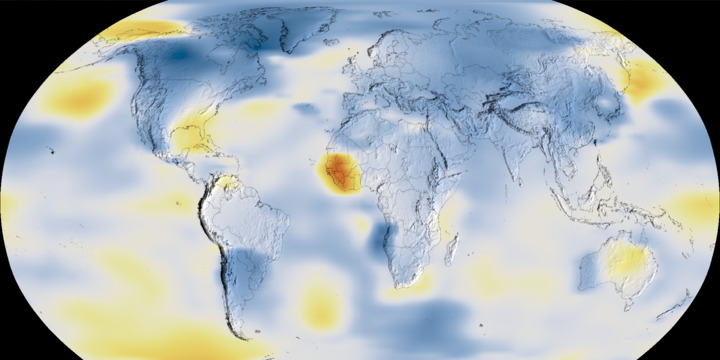
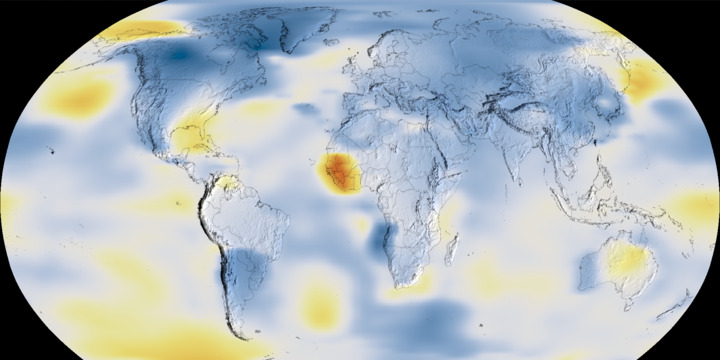
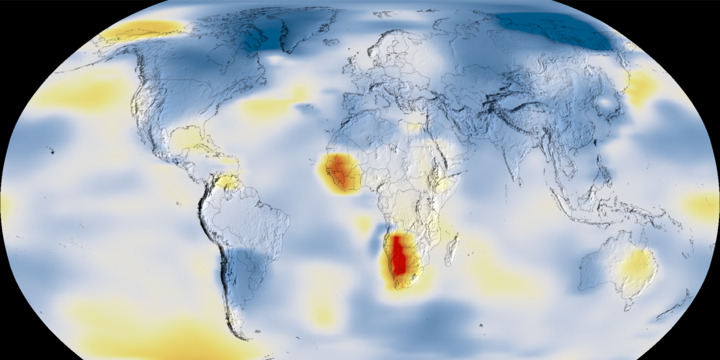


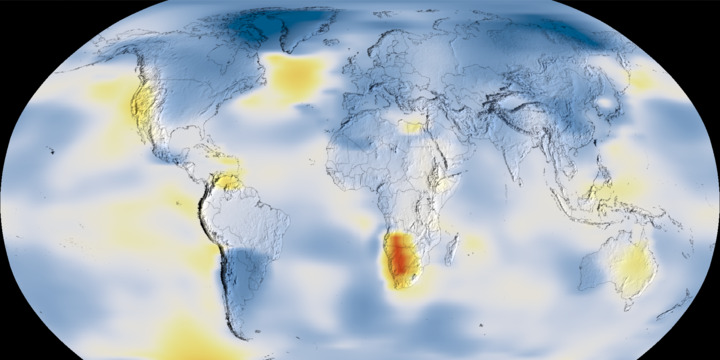
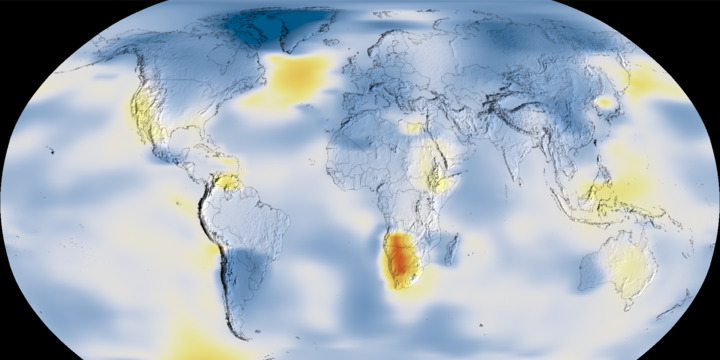
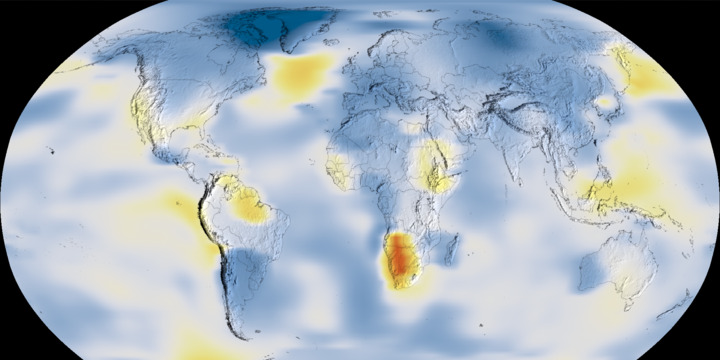
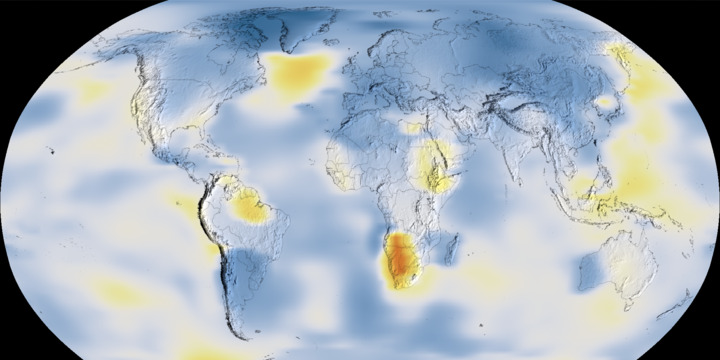
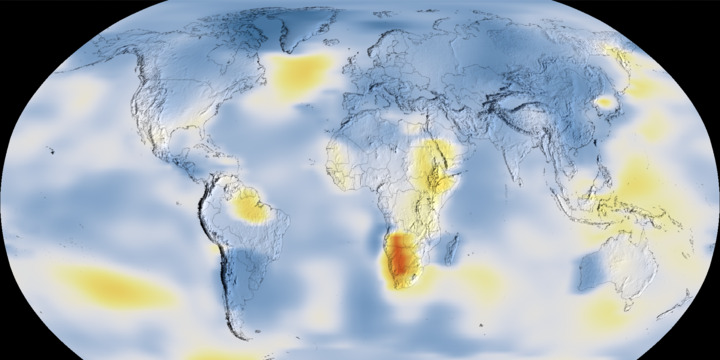
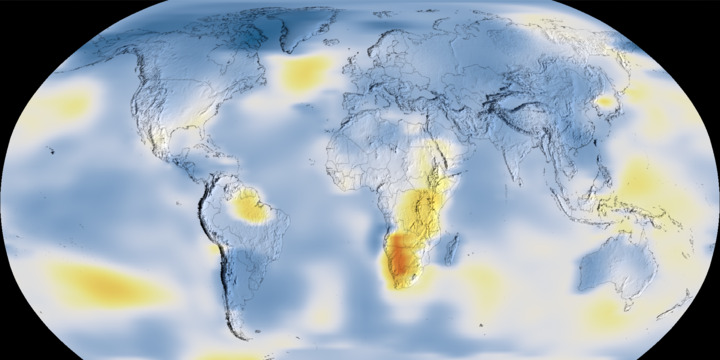
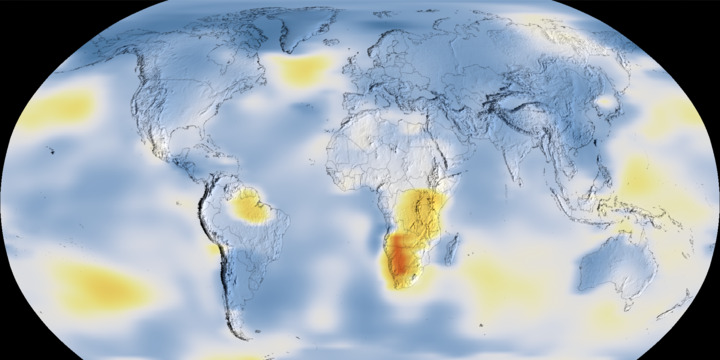
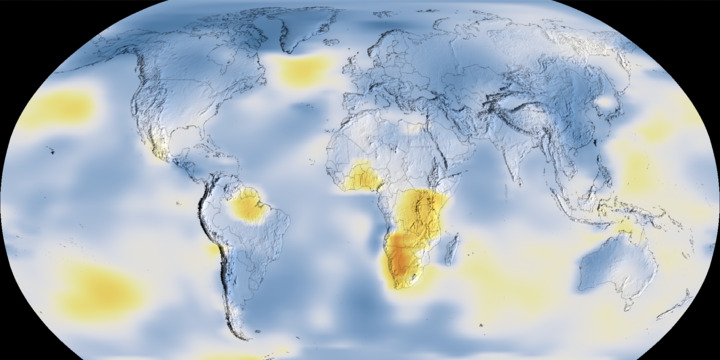
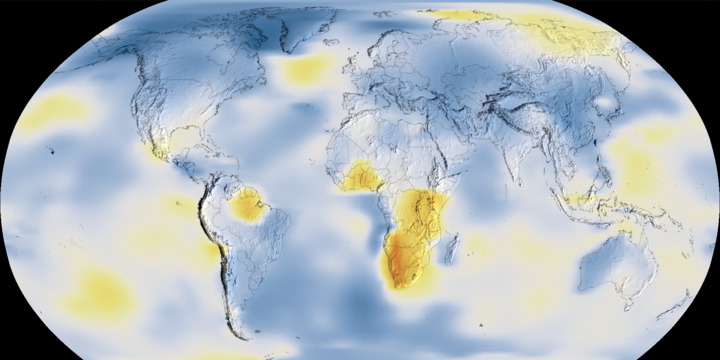
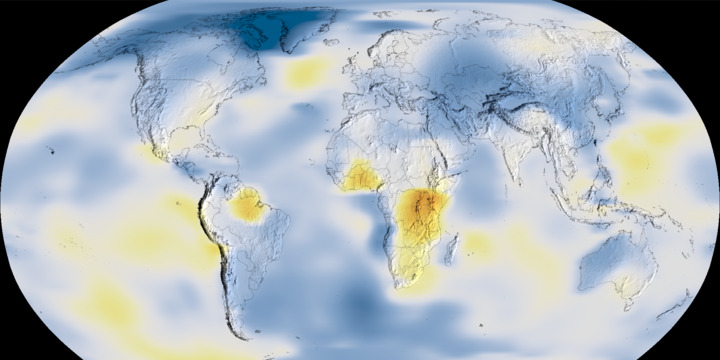
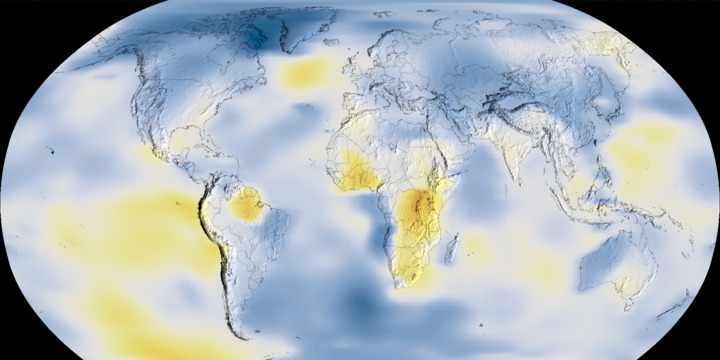
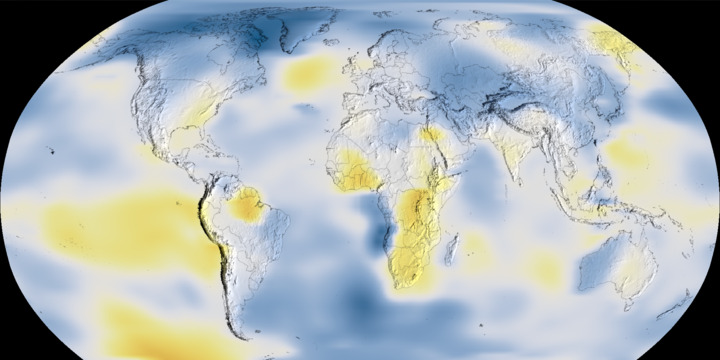
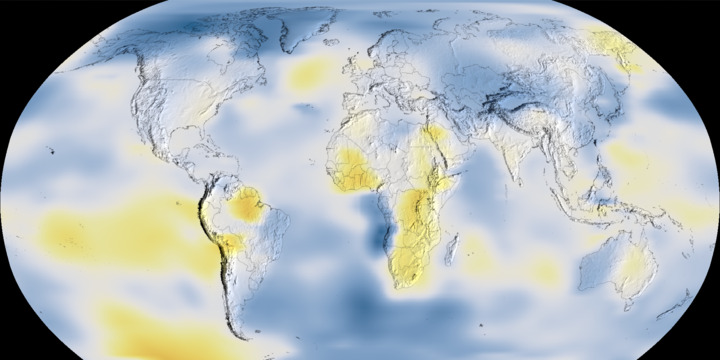
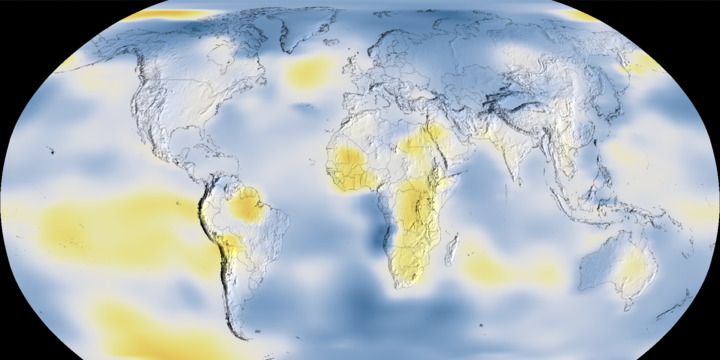


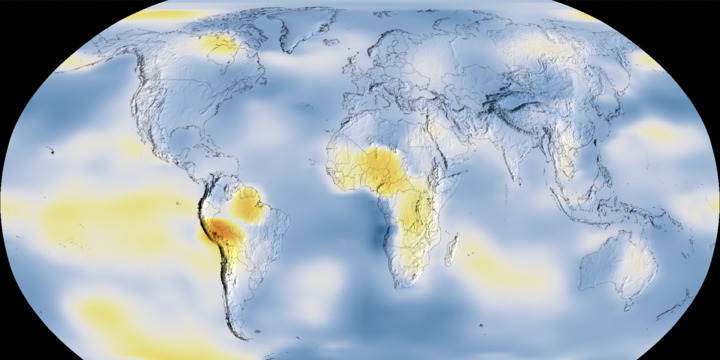
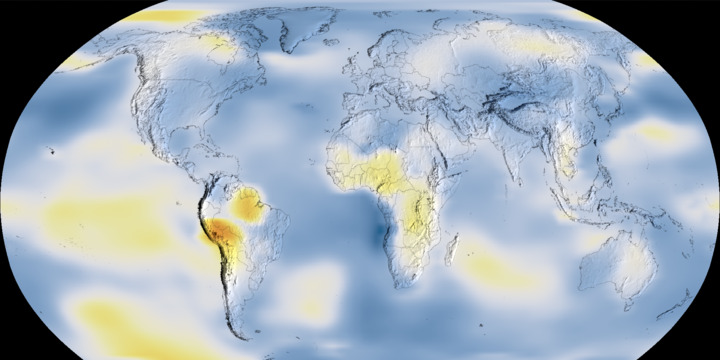
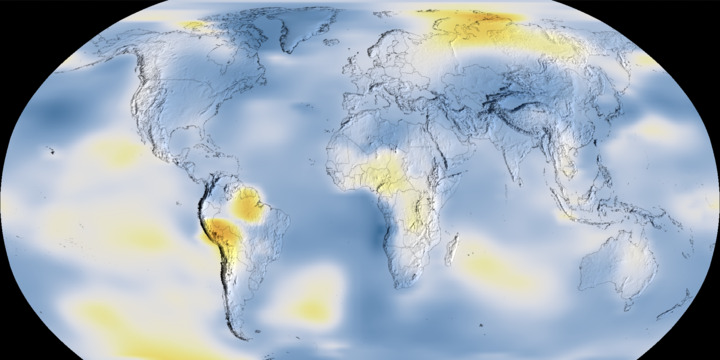

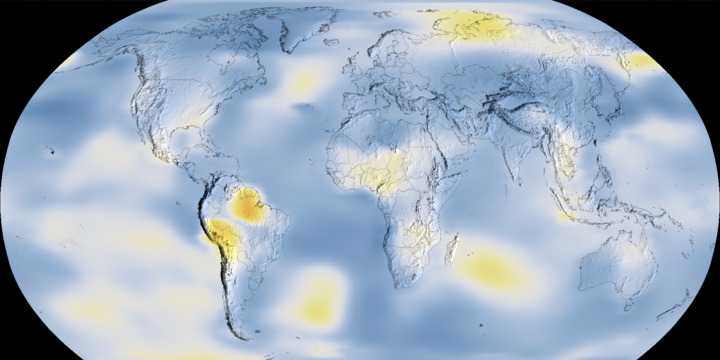
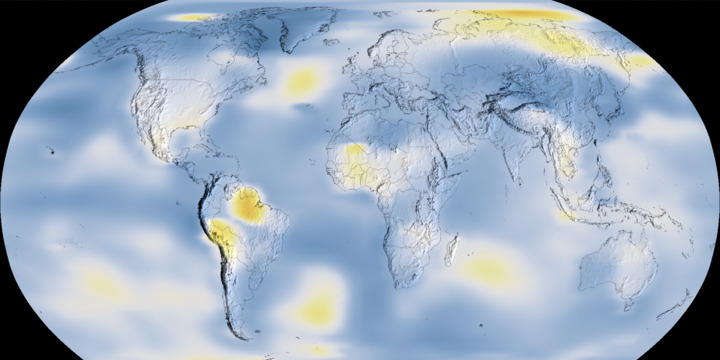
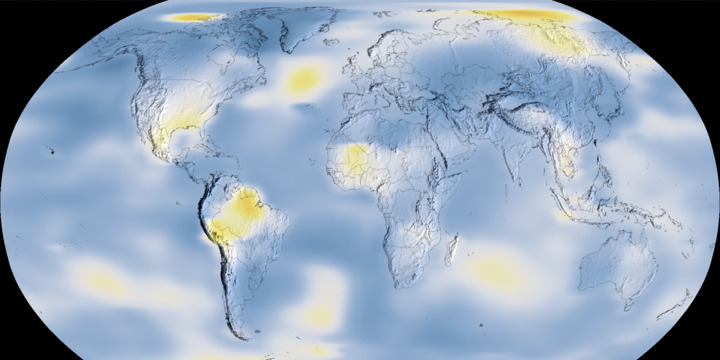

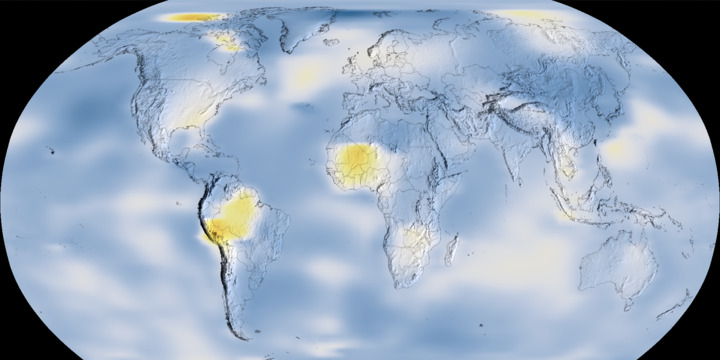
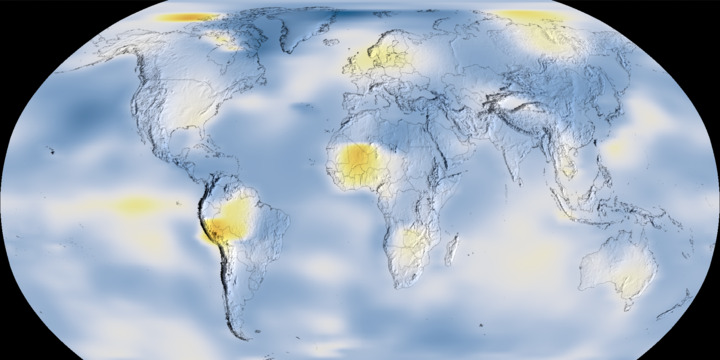
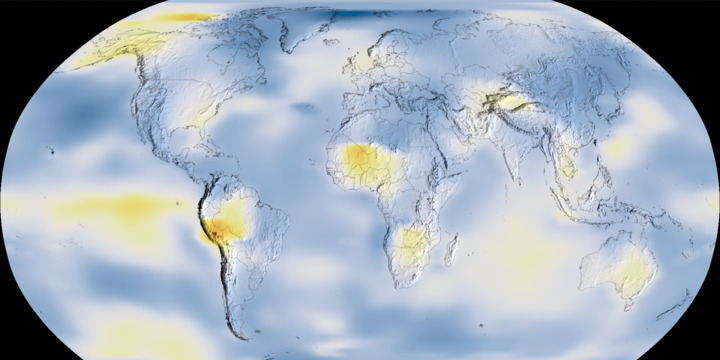
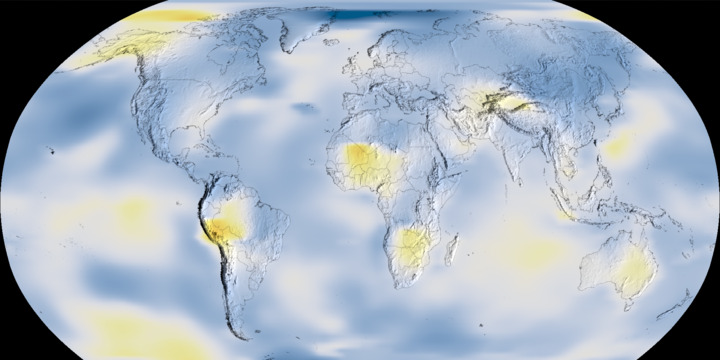
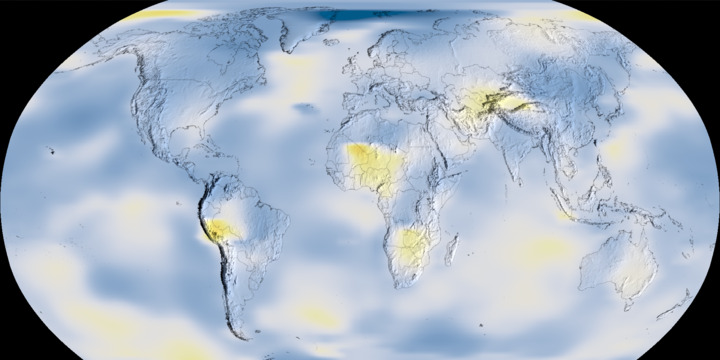
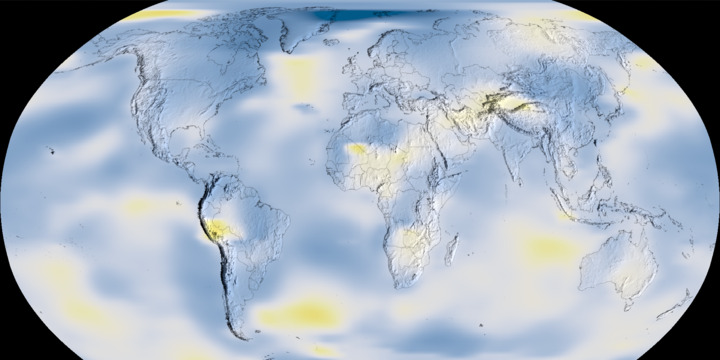
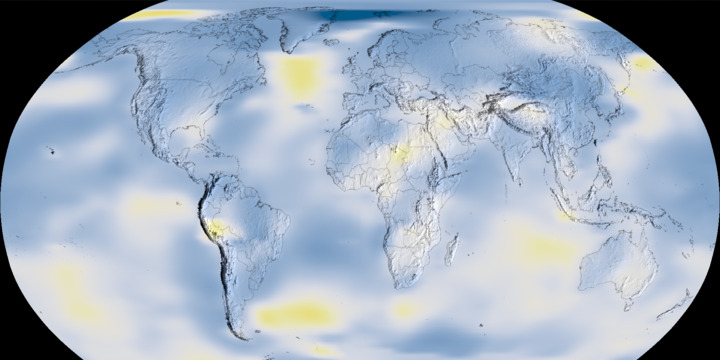


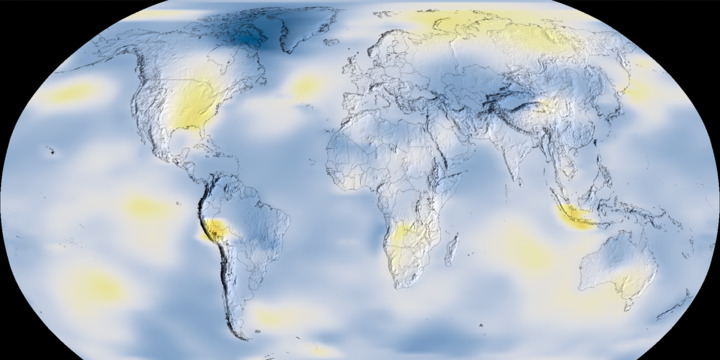
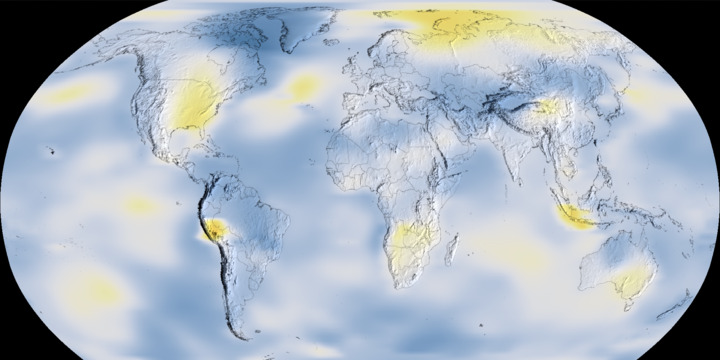

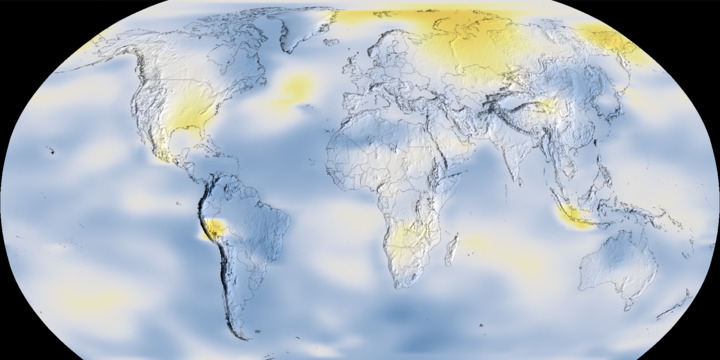
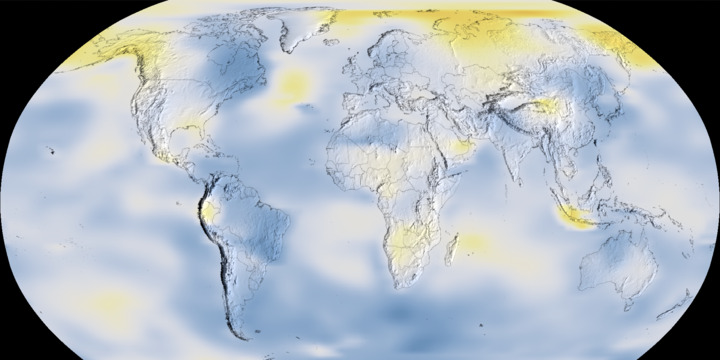
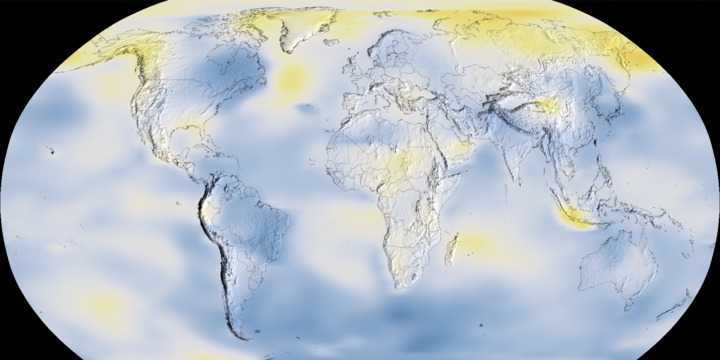
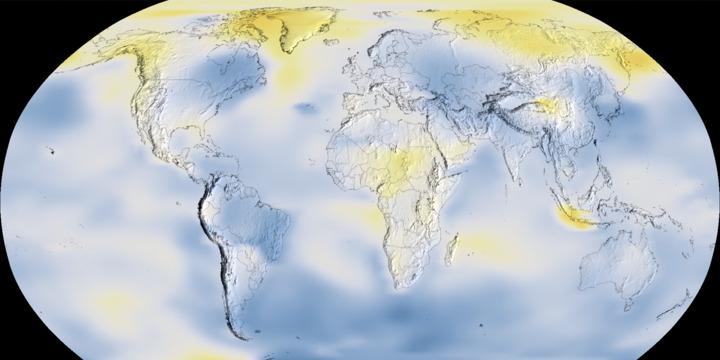
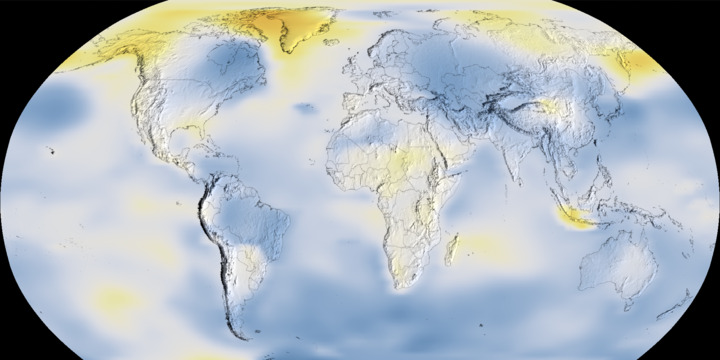
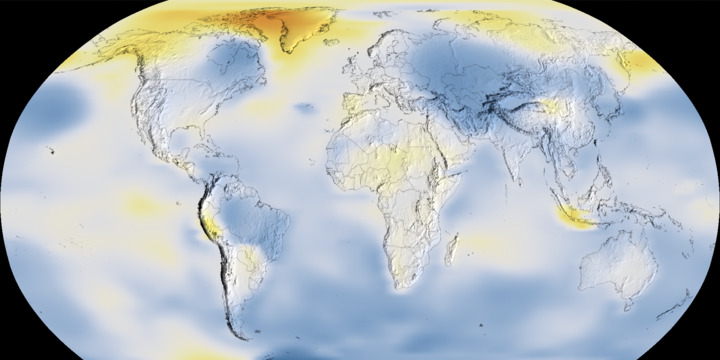
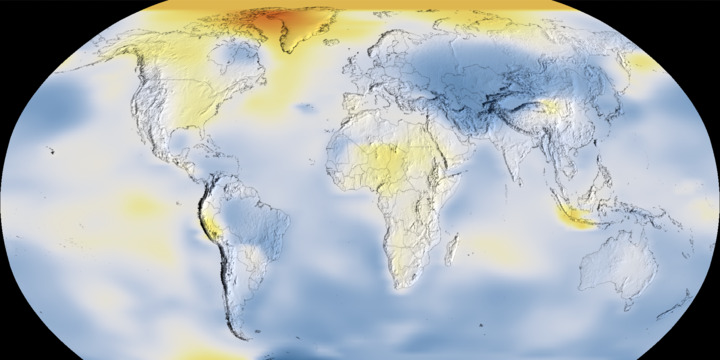
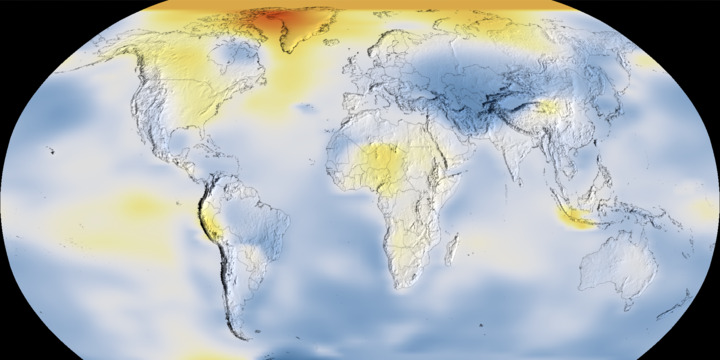
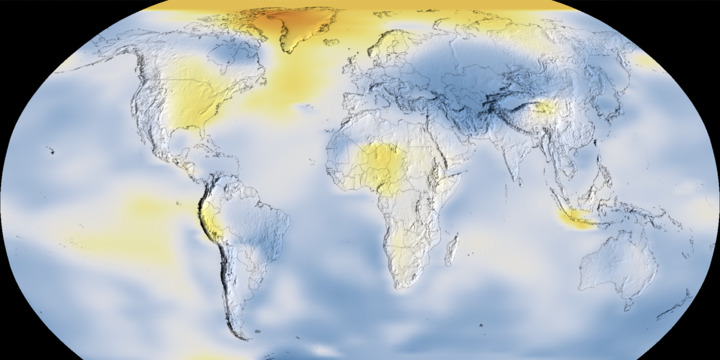

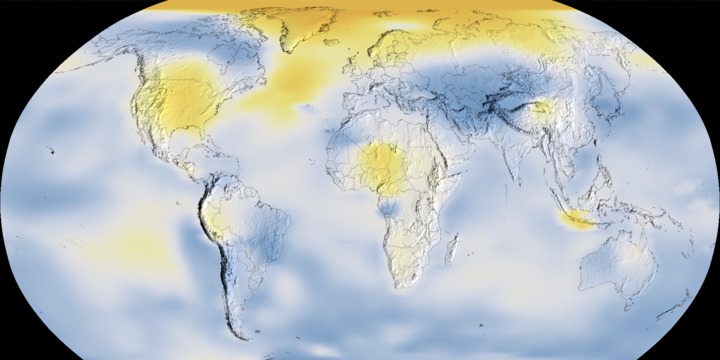
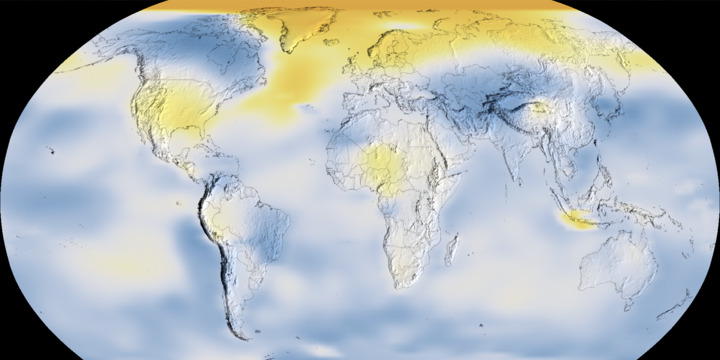
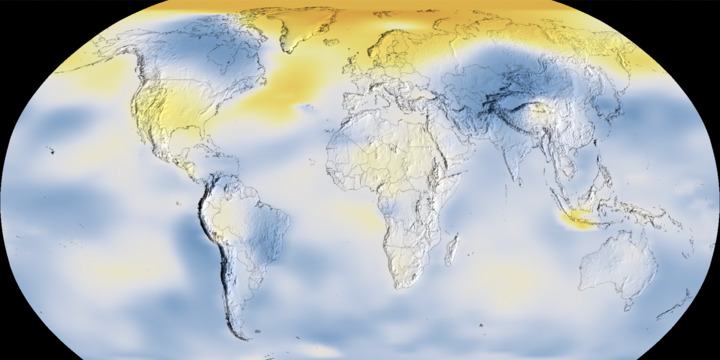
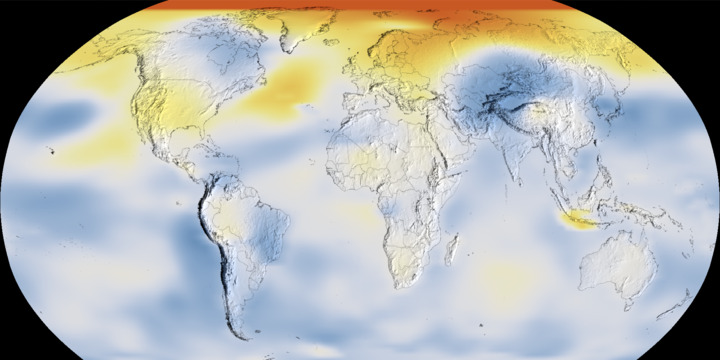

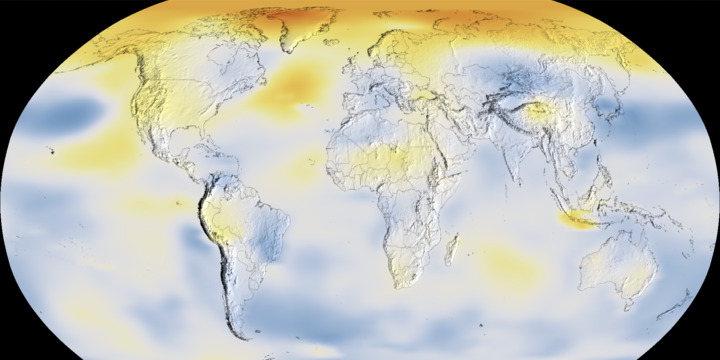
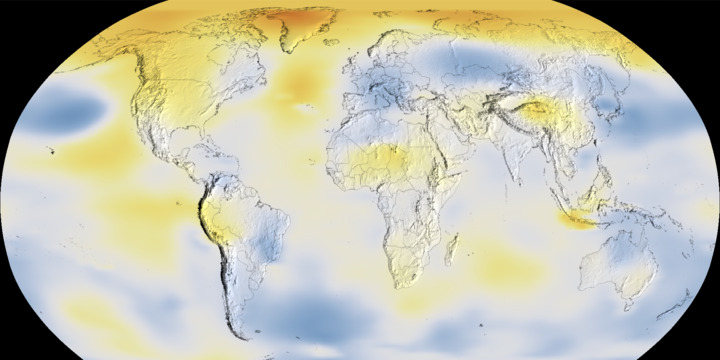
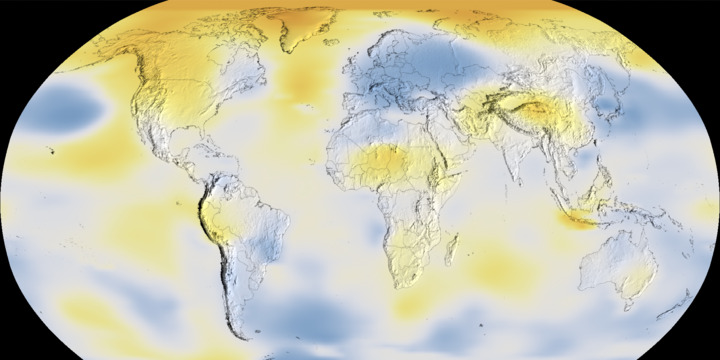
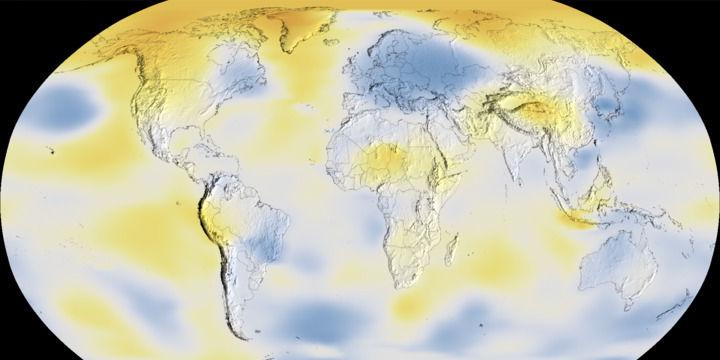
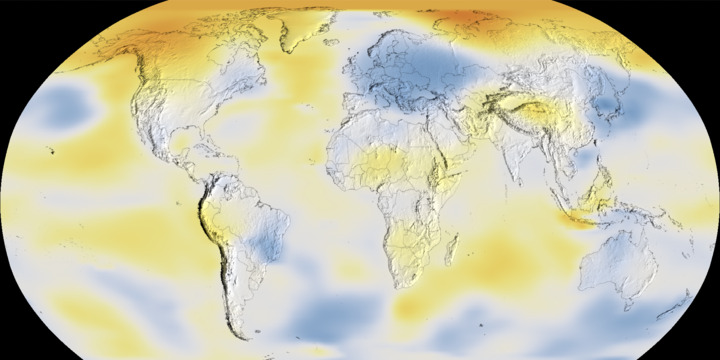
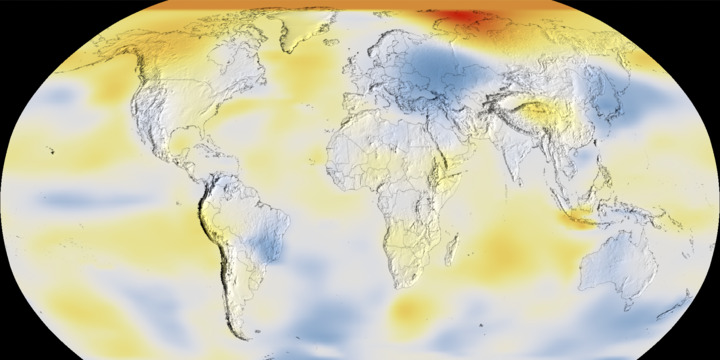
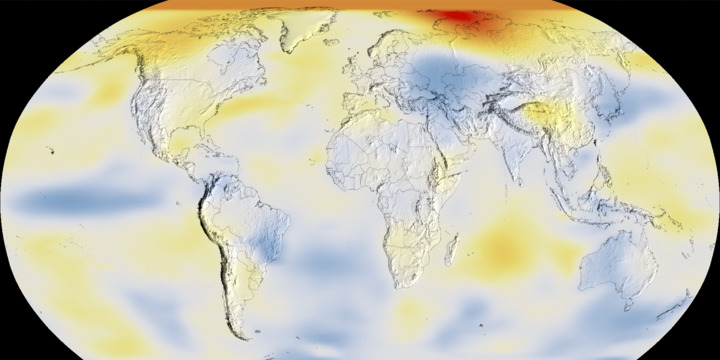
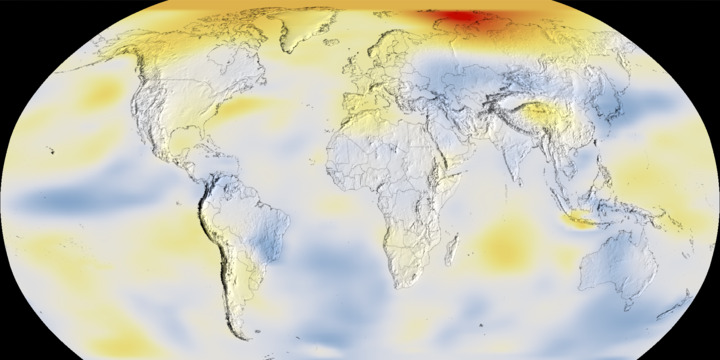
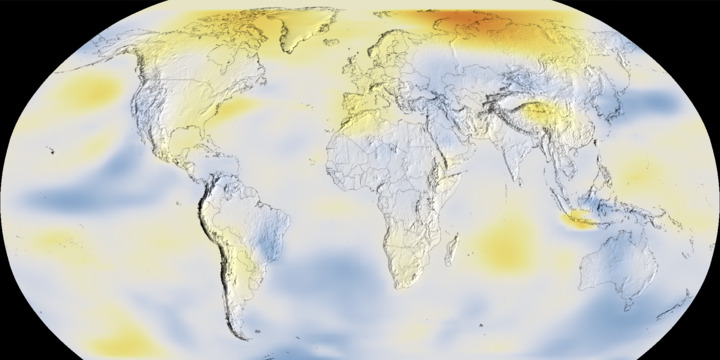
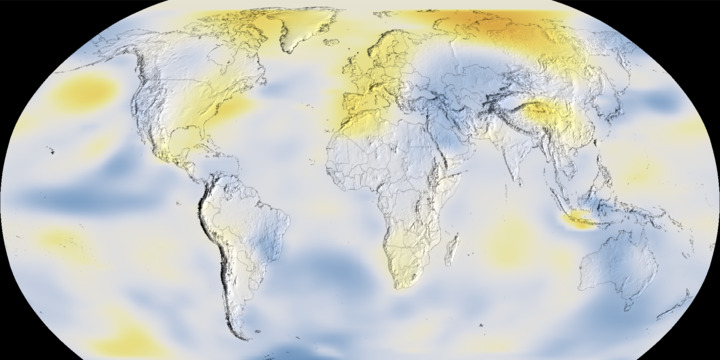

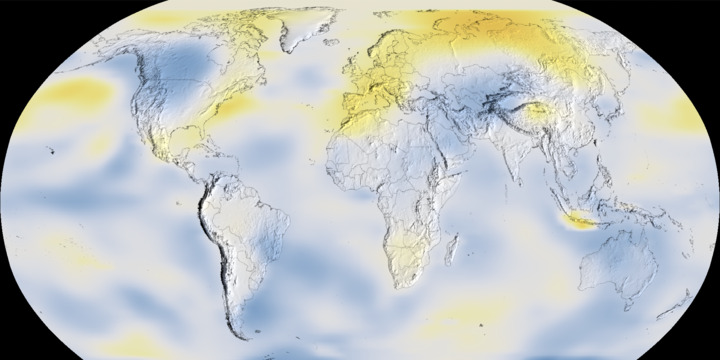

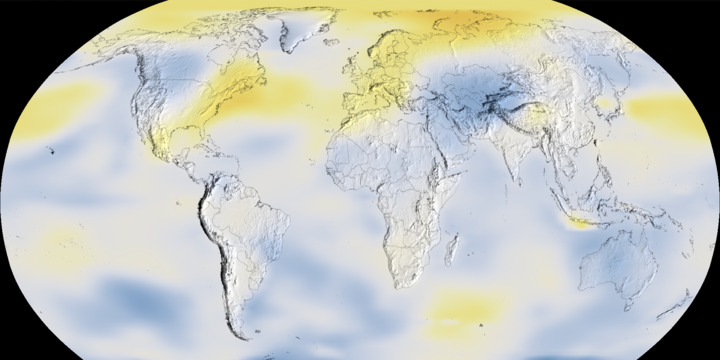
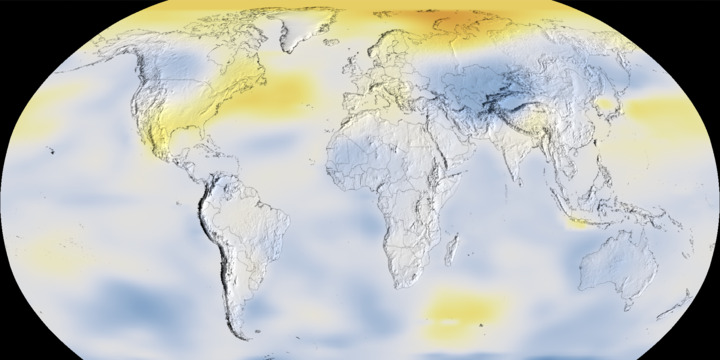
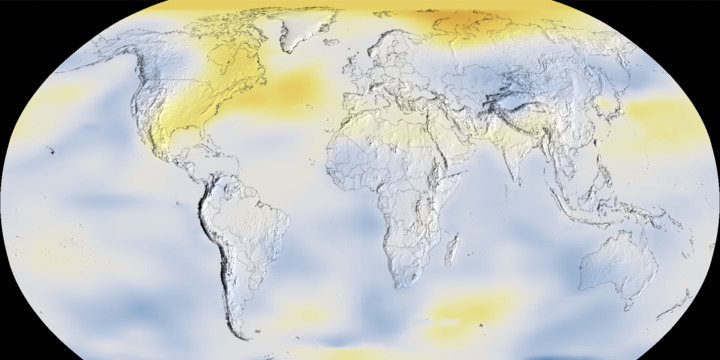
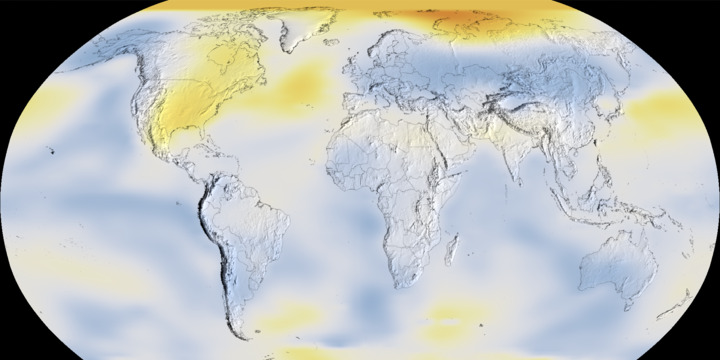
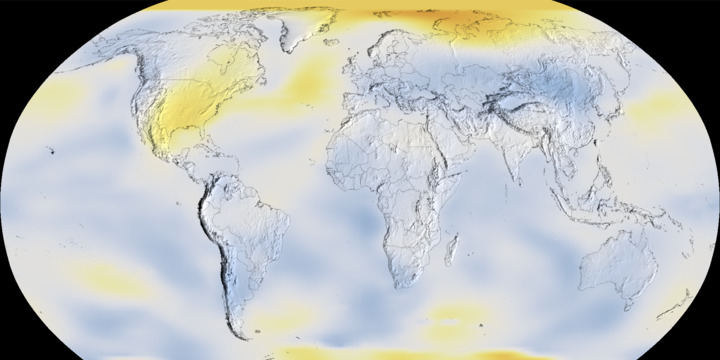
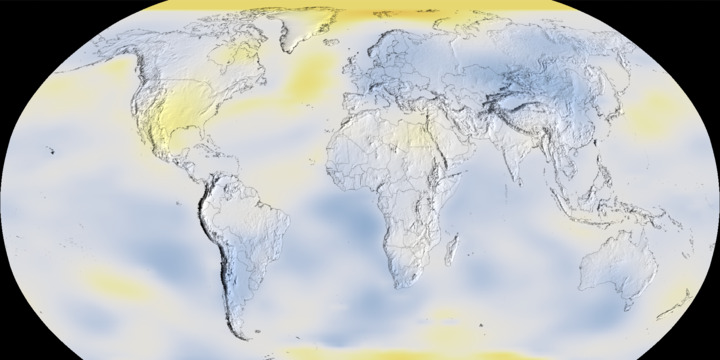
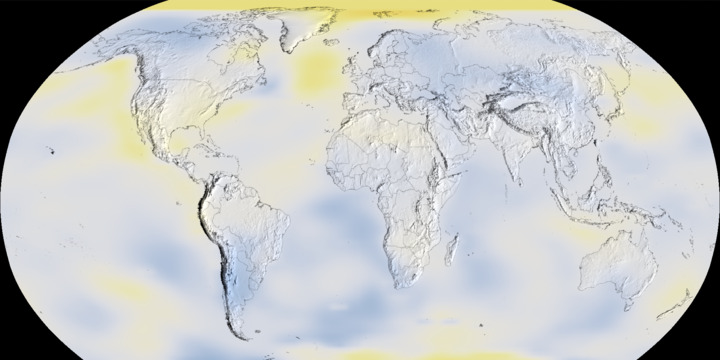
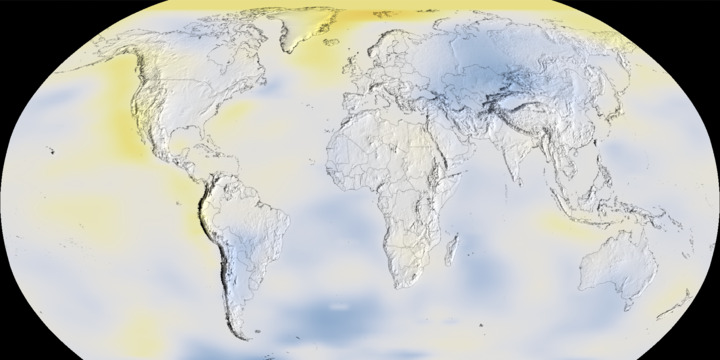
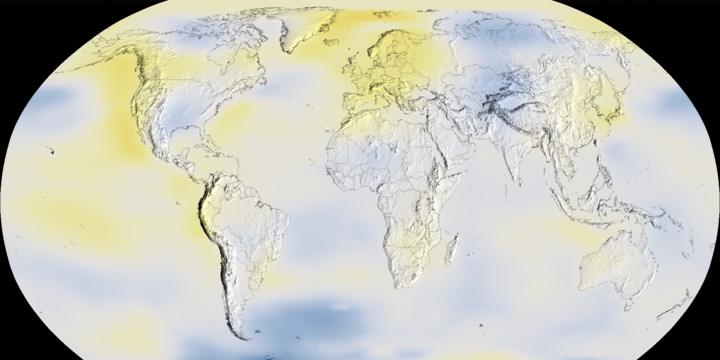
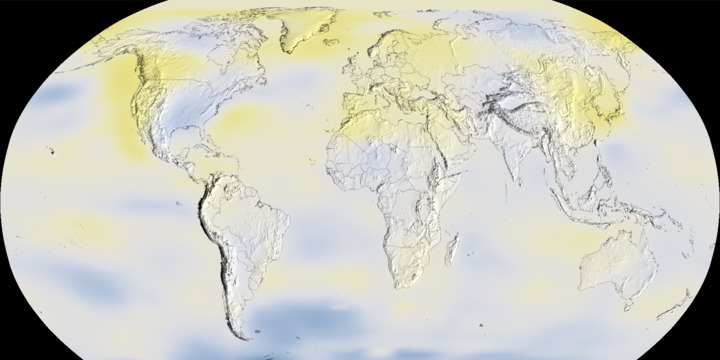
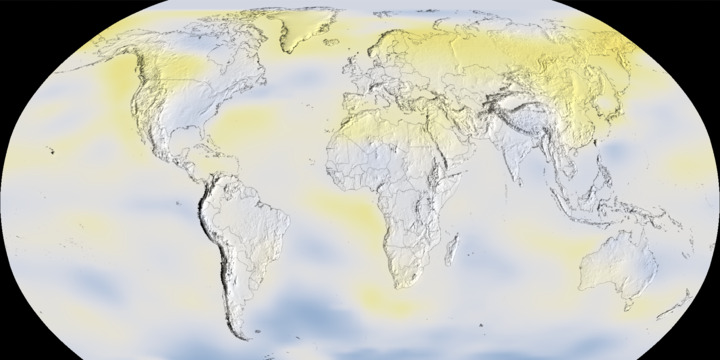
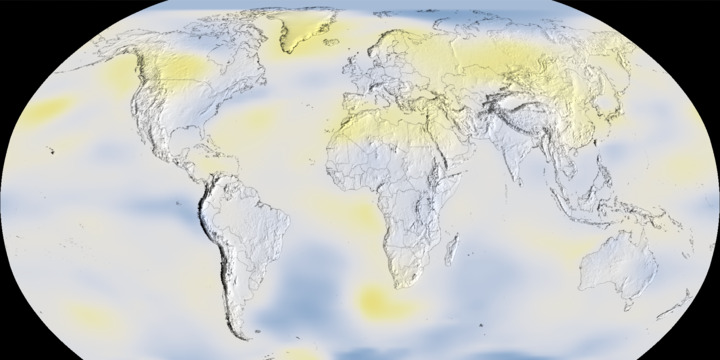
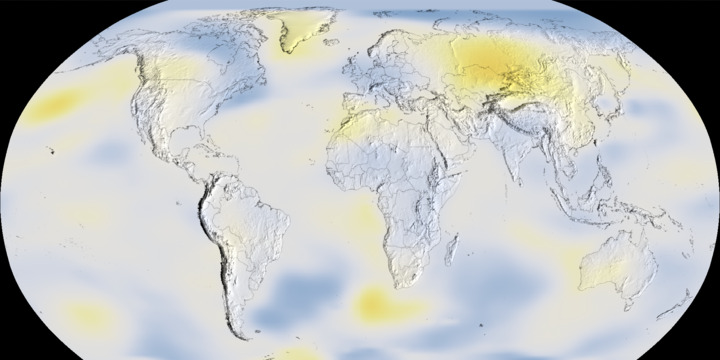
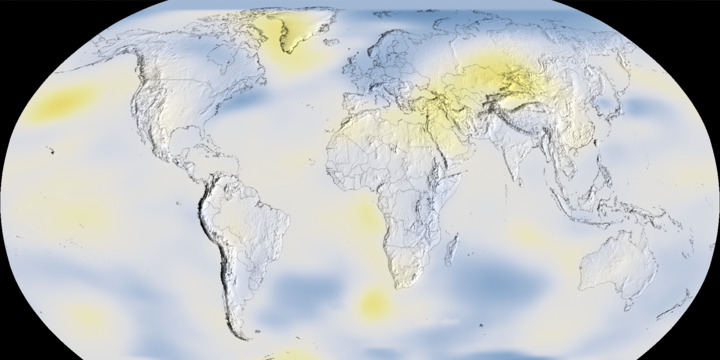
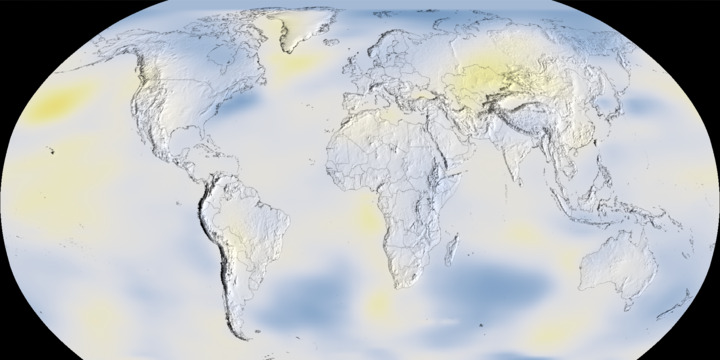
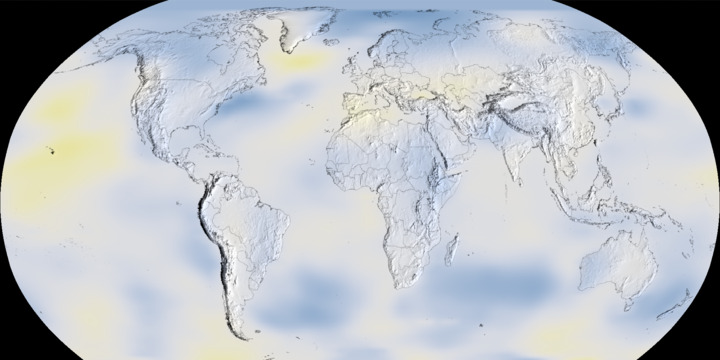
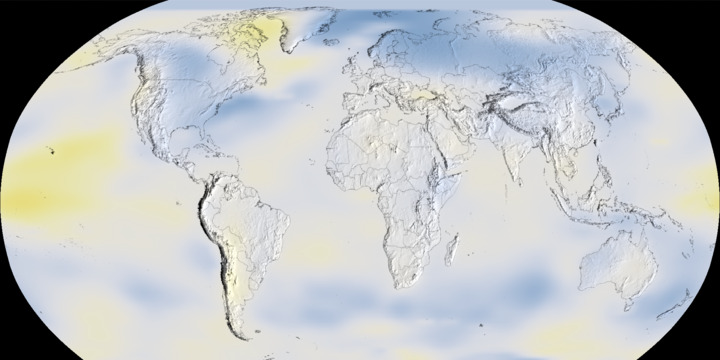
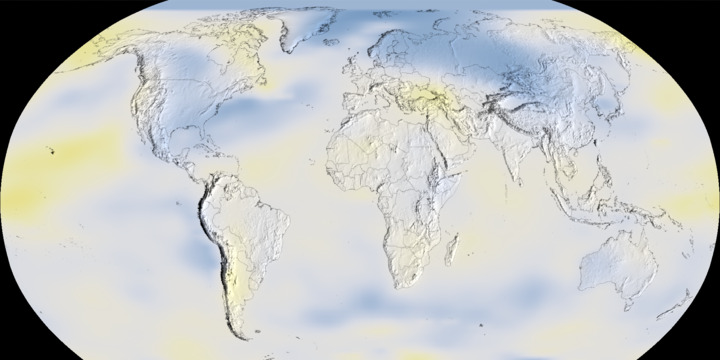
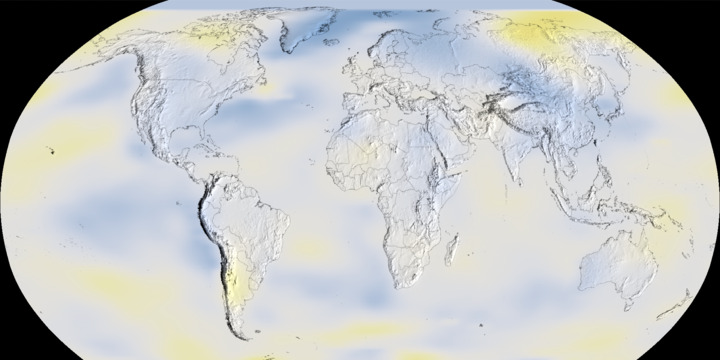
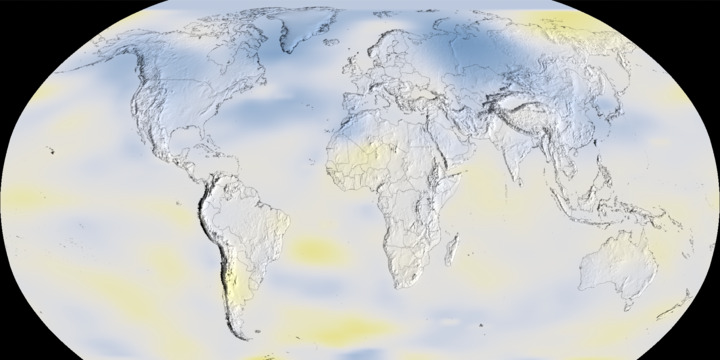
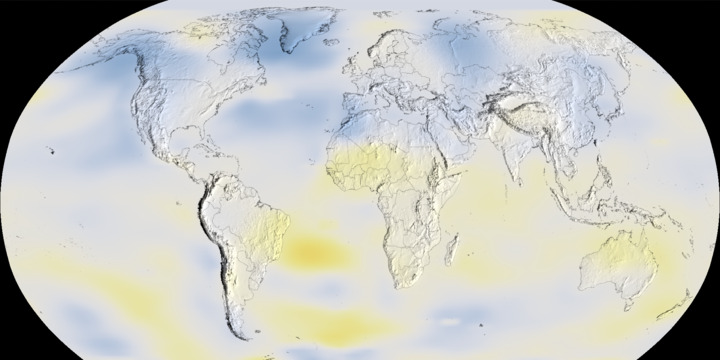
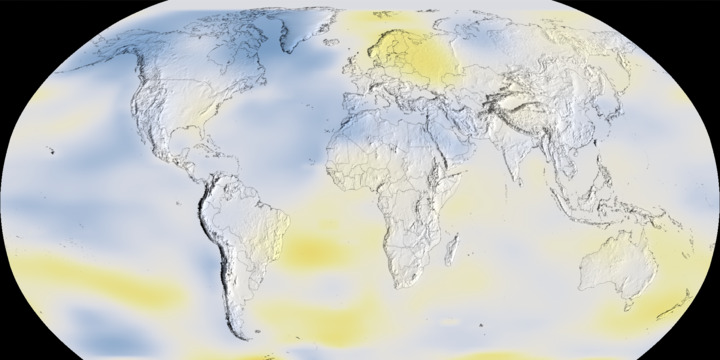


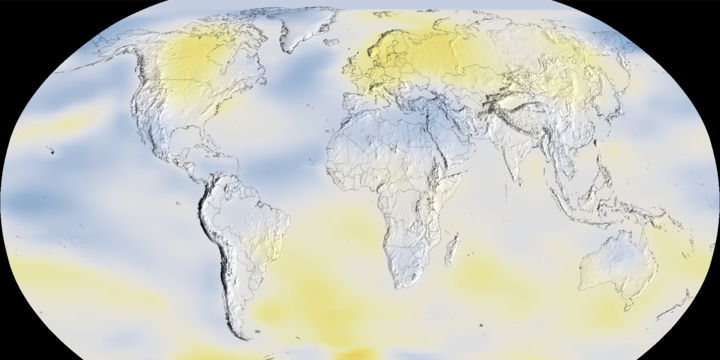
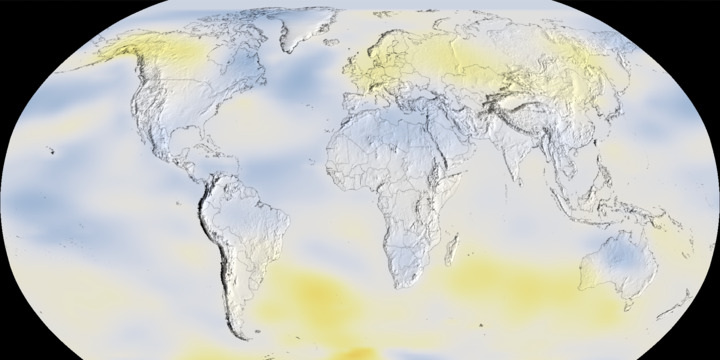
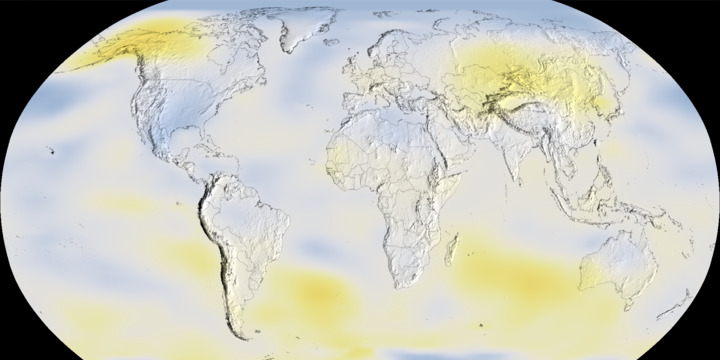



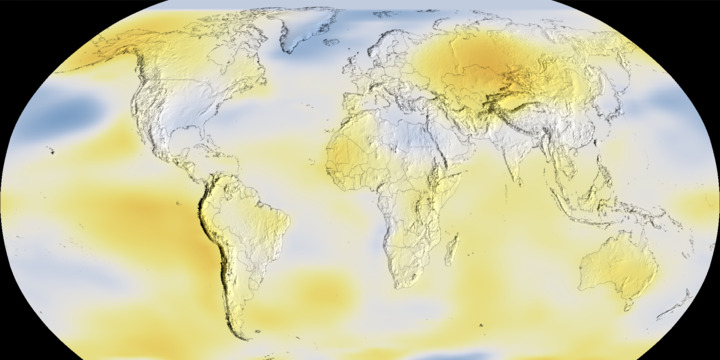
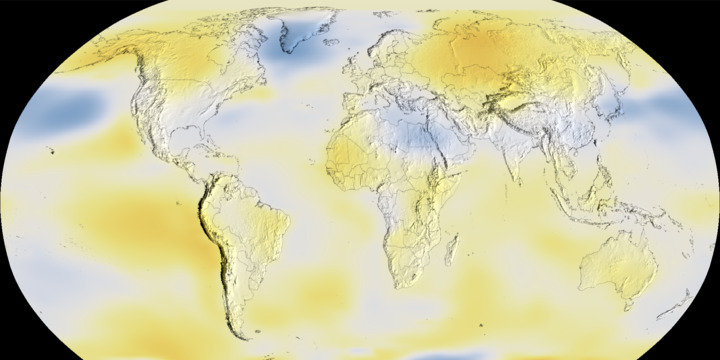

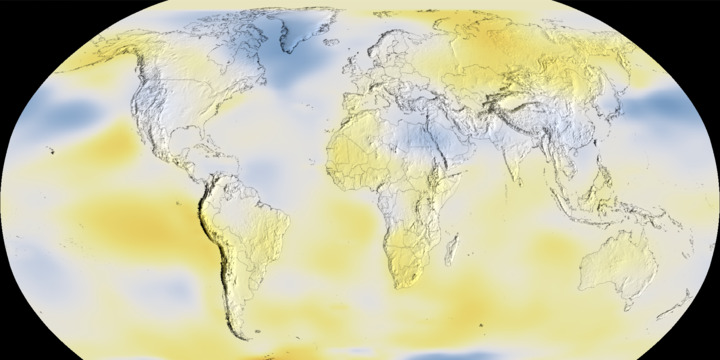
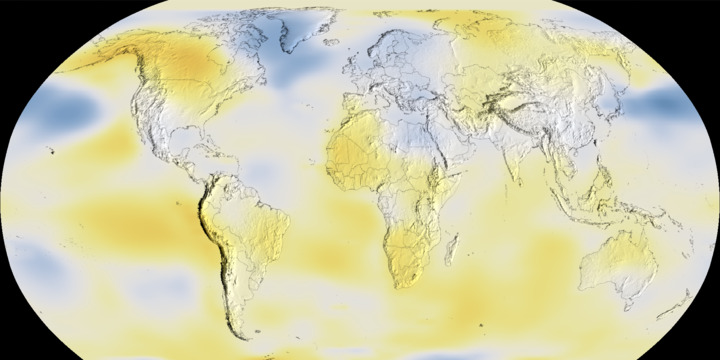




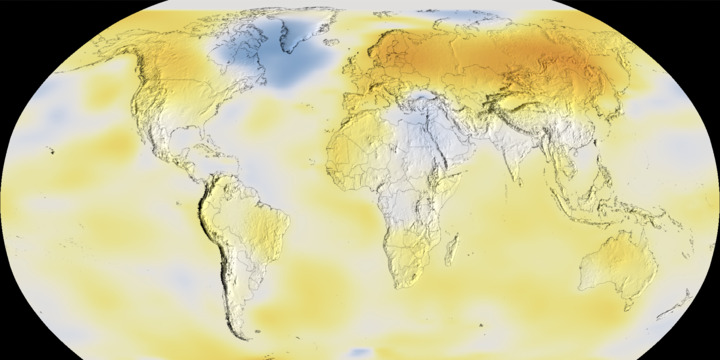

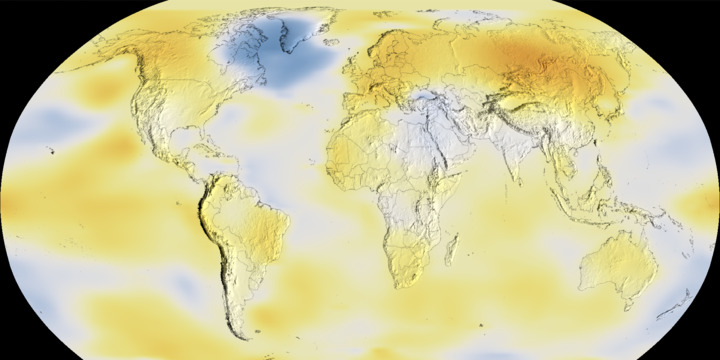
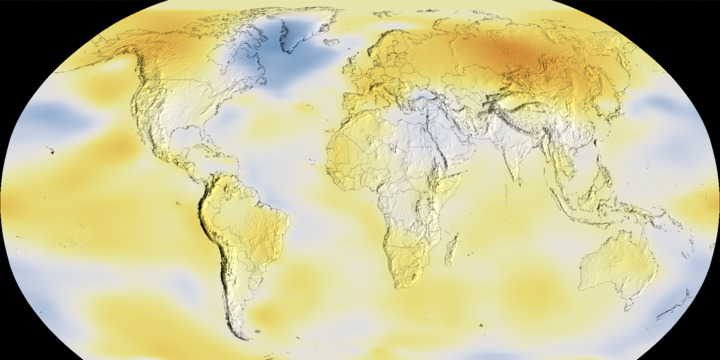
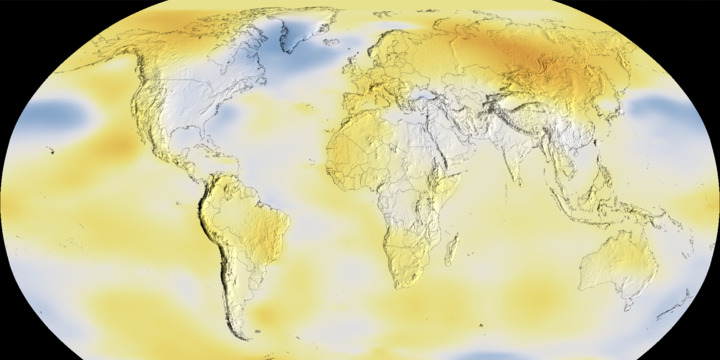
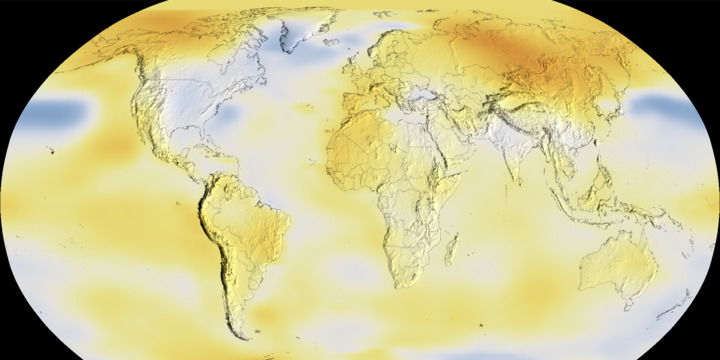
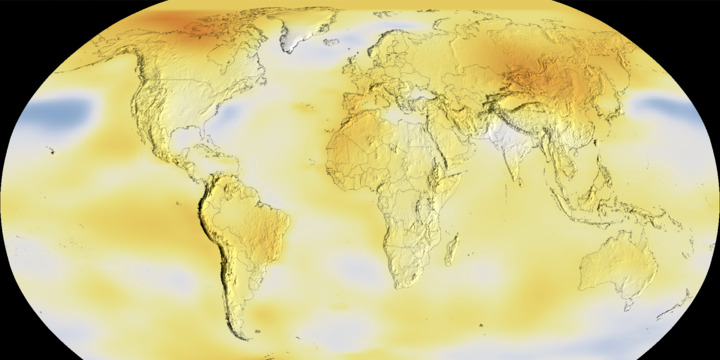
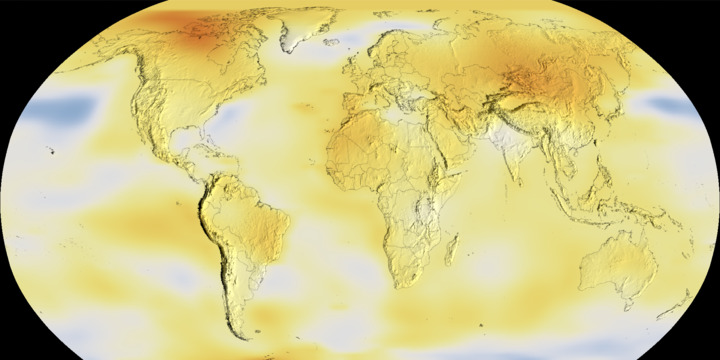
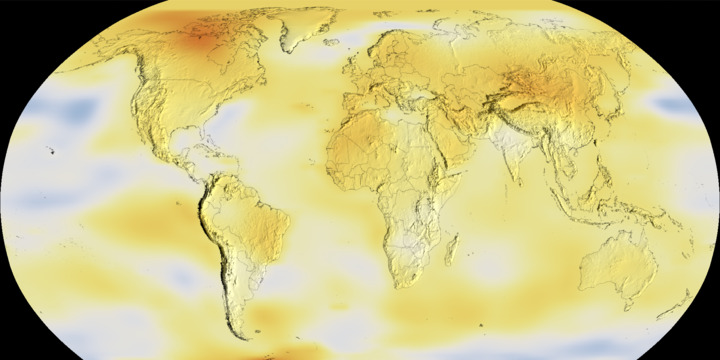
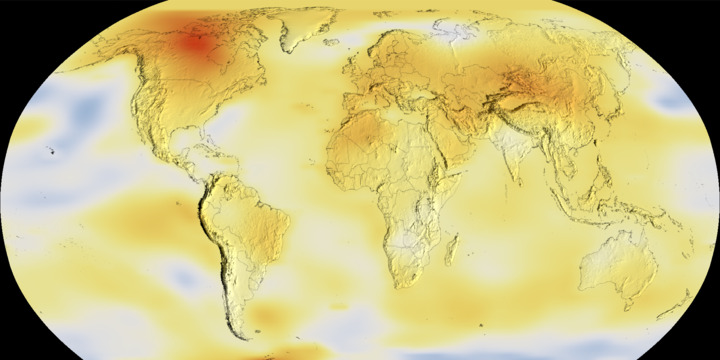
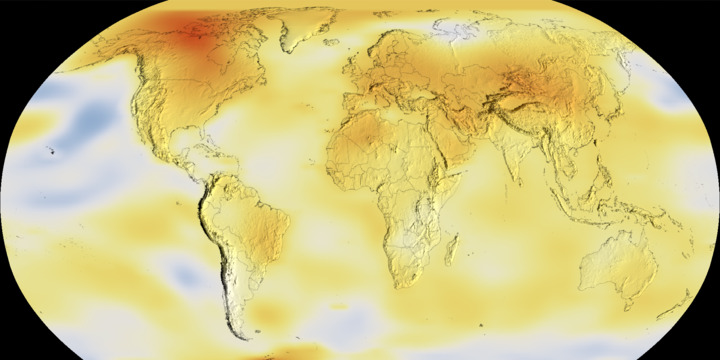
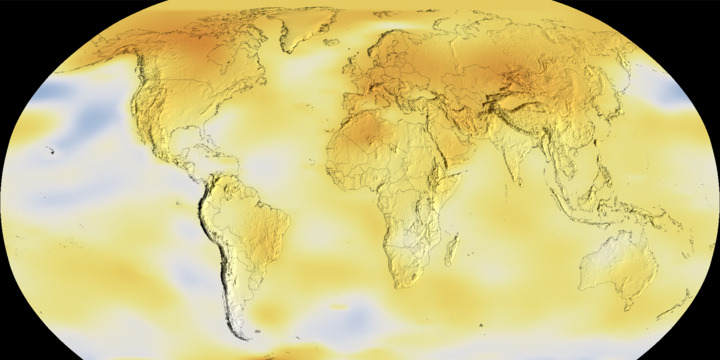
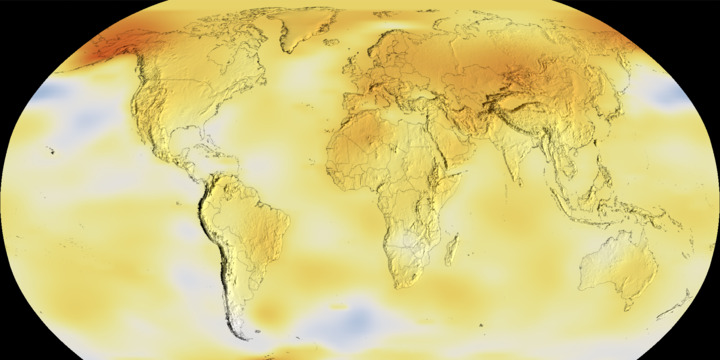
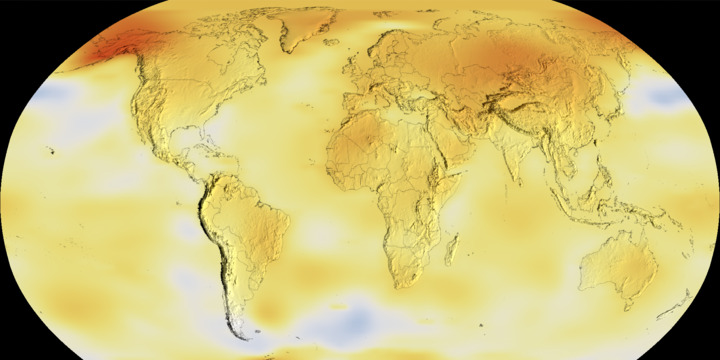
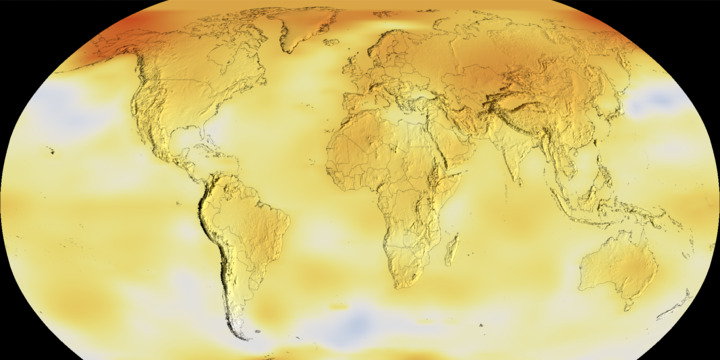
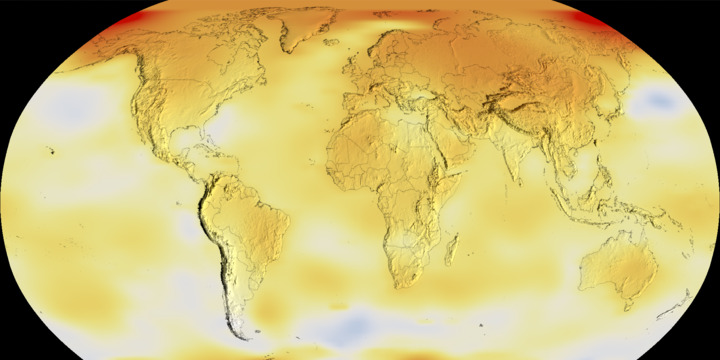

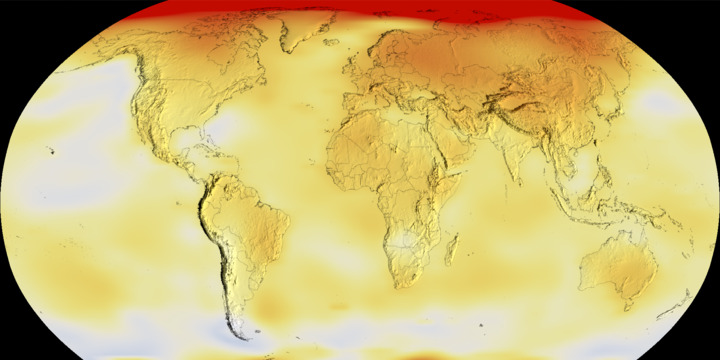
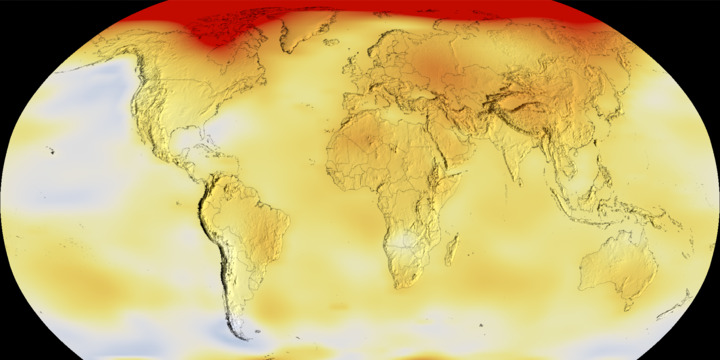
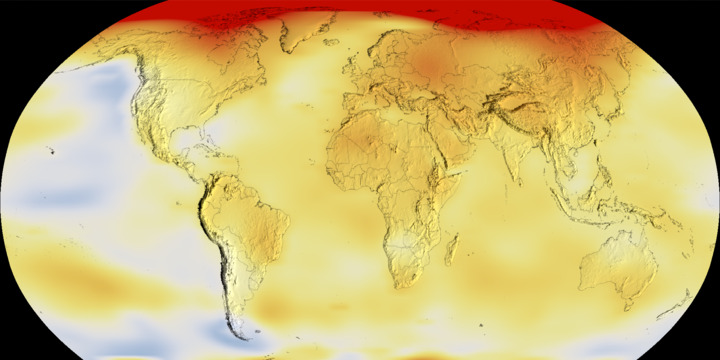
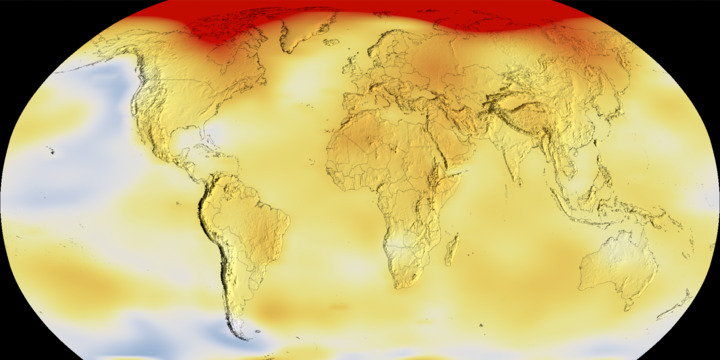
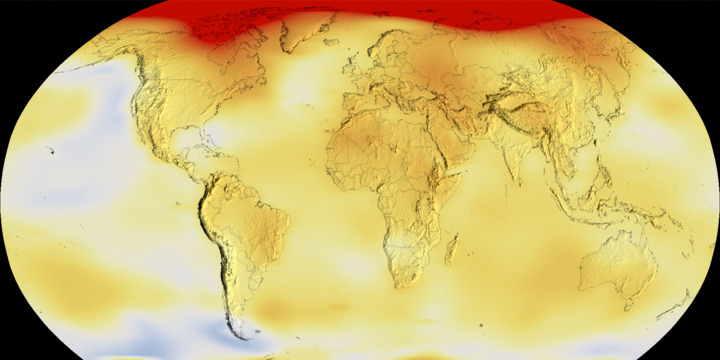
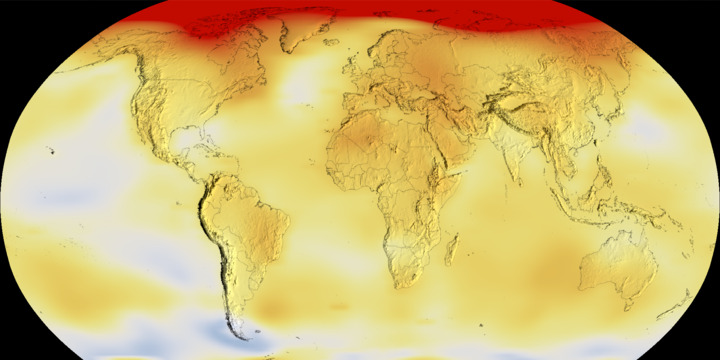
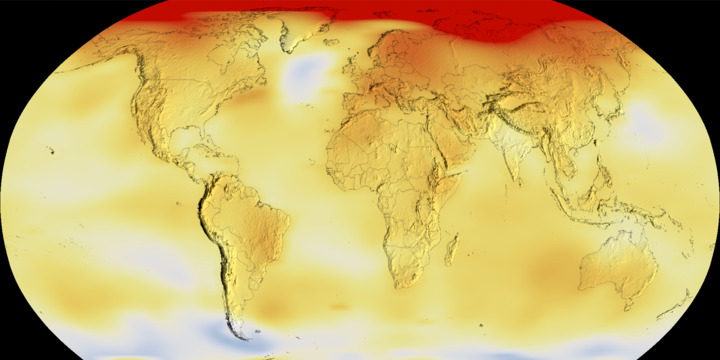
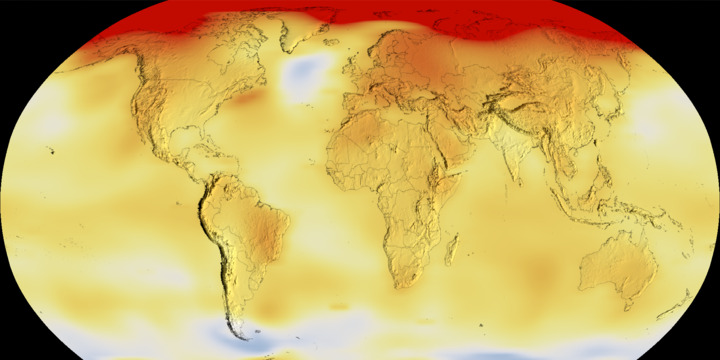
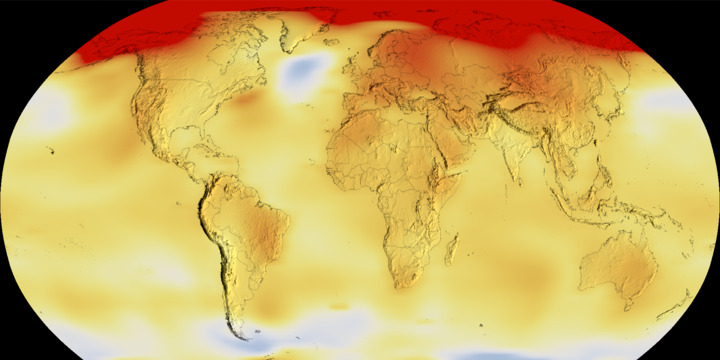
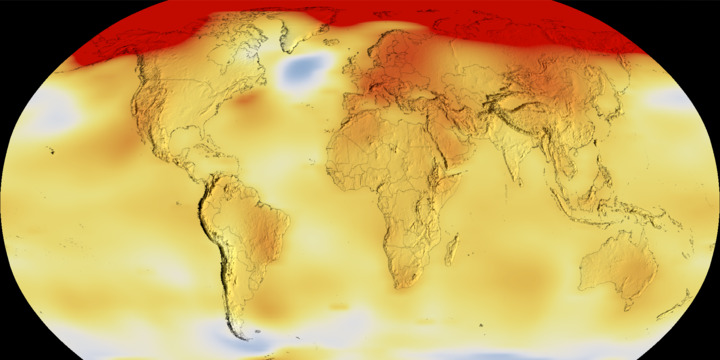
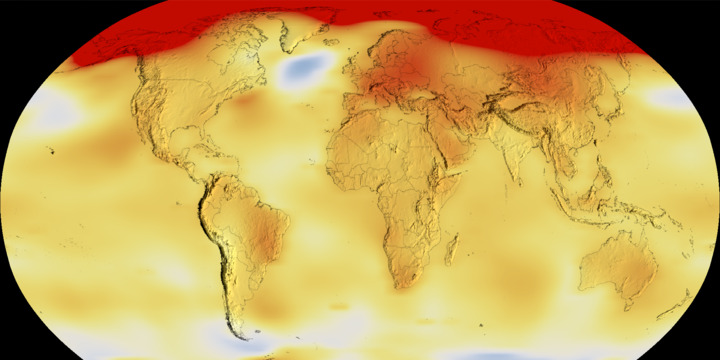
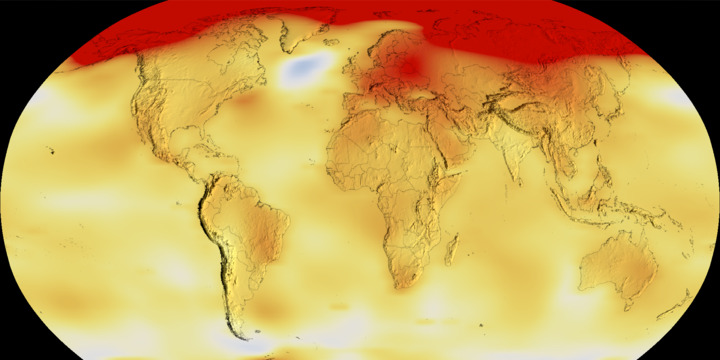
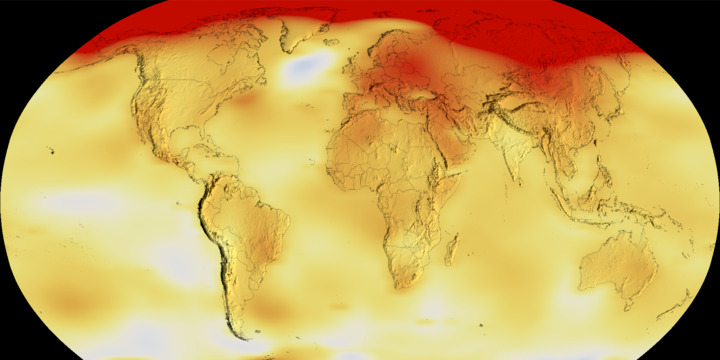
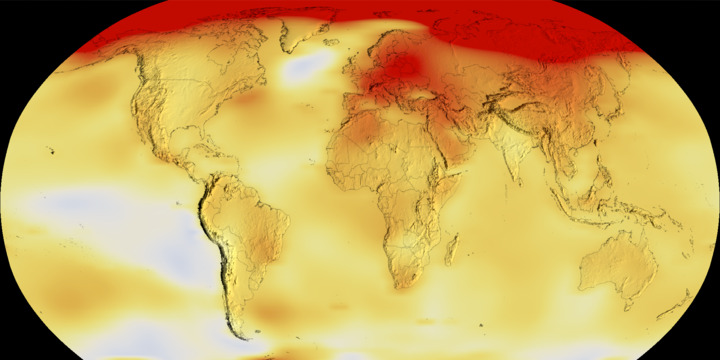

1884
2022
The animation on the right shows the change in global surface temperatures. Dark blue shows areas cooler than average. Dark red shows areas warmer than average. Short-term variations are smoothed out using a 5-year running average to make trends more visible in this map.
Sea Level
Sea level refers to the average height of the ocean’s surface.

The Earth’s seas are rising at a higher rate than they have in the past. This change is a direct result of a changing climate.
Increased Greenhouse Gases Lead to Global Sea Level Rise
This animation shows the rise in global mean sea level from 1993 to 2023 based on data from a series of five international satellites. The spike in sea level from 2022 to 2023 is mostly a consequence of climate change and the development of El Niño conditions in the Pacific Ocean.Credit: NASA's Scientific Visualization Studio.
What Couses Global Sea Level Rise?
- Greenhouse gases added to the atmosphere by human activities are warming the planet.
- Global sea level is rising mainly from ocean warming and melting land ice due to climate change.
- Global sea level is rising faster today than it was 100 years ago.

- For over 100 years, humans have burned coal, gas, and oil to produce energy. Burning these fossil fuels releases greenhouse gases into the air.
- Around 90% of the added heat from greenhouse gases is being absorbed by the ocean, warming it up.Currently, about one third (around 33%) of global sea level rise is because of ocean warming.
- As Earth heats up, it melts the land ice, including the Greenland and Antarctic Ice Sheets and other mountain glaciers. The water then flows into the ocean which raises sea levels. Around 66% of global sea level rise is because of melting land ice.
Ocean Warming
The Ocean's Role as Earth's Heat Sink
The ocean has absorbed about 90% of the excess heat trapped by greenhouse gases, making it a crucial indicator of climate change.
Heat Absorption: ~93% of excess heat goes into oceans
Temperature Rise: Upper 2000m warmed by ~0.6°C since 1969
Rate of Warming: Accelerating, especially since 1990s
Impacts of Ocean Warming:
- Thermal expansion contributing to sea level rise
- Changes in ocean circulation patterns
- Marine ecosystem disruption
- Coral bleaching events
- Altered weather patterns globally
- Reduced oxygen levels in seawater
Ice Sheets
Greenland Ice Sheet
The world's second-largest ice sheet, covering ~80% of Greenland's surface.
Ice Loss Rate: ~280 billion tons per year
Sea Level Potential: ~7.4 meters if completely melted
Current Contribution: ~0.7mm/year to sea level rise
Antarctic Ice Sheet
The world's largest ice sheet, containing ~90% of Earth's fresh water.
Ice Loss Rate: ~150 billion tons per year
Sea Level Potential: ~58.3 meters if completely melted
Most Vulnerable: West Antarctic Ice Sheet
Key Processes:
Surface Melting
Direct melting from warm air temperatures
Basal Melting
Melting from underneath by warm ocean water
Calving
Ice breaking off into icebergs at the edges
Albedo Effect
Less ice means less sunlight reflection
Arctic Sea Ice
Current Trends
Arctic sea ice is declining at an unprecedented rate, with significant implications for global climate.
Decline Rate: ~13% per decade since 1979
Minimum Extent: Occurs in September each year
Thickness Loss: ~66% thinner than in 1958
Climate Impacts
- Reduced albedo (ice reflects sunlight)
- Increased heat absorption by dark ocean
- Disrupted polar weather patterns
- Habitat loss for Arctic wildlife
- Changes in ocean circulation
- Potential for Arctic shipping routes
Feedback Loops:
Ice-Albedo Feedback:
Less ice → More dark ocean surface → More heat absorption → More warming → Even less ice formation
Summer Ice Loss
Arctic could be ice-free in summer by 2050
Global Impact
Arctic warming affects weather worldwide
Natural Hazards
What Natural Hazard Means?
Natural hazards are extreme environmental events that have the potential to cause significant harm to human societies and the environment. These events can lead to loss of life, injury, property damage, and disruption of human activities


Climate change increases the frequency and severity of natural hazards like heatwaves, floods, droughts, and storms by altering temperatures, precipitation patterns, and sea levels.
What is Drought?

Drought is a prolonged period of abnormally low rainfall, leading to water shortages, low soil moisture, and stressed vegetation. It affects agriculture, ecosystems, and water supplies.

The National Weather Service office of the NOAA defines drought as "a deficiency of moisture that results in adverse impacts on people, animals, or vegetation over a sizeable area".
Categories
There are three major categories of drought based on where in the water cycle the moisture deficit occurs:

Meteorological
- Meteorological Drought occurs when there is a prolonged time with less than average precipitation.
- Usually precedes the other kinds of drought.
- As the drought persists, the conditions surrounding it gradually worsen and its impact on the local population gradually increases.

Hydrological
- Hydrological drought is brought about when the water reserves available in sources fall below a locally significant threshold.
- Tends to show up more slowly because it involves stored water that is used but not replenished.

Agricultural
- Agricultural or ecological droughts affect crop production or ecosystems in general
- Also arise independently from any change in precipitation levels when either increased irrigation or soil conditions and erosion triggered by poorly planned agricultural endeavors cause a shortfall in water available to the crops.
What Causes Drought?
Drought is a recurring feature of the climate in most parts of the world, becoming more extreme and less predictable due to climate change.

General Precipitation Deficiency

Dry season

Climate change

El Niño–Southern Oscillation (ENSO)

Erosion and human activities
Impacts
Droughts are the second-most costly weather events after hurricanes. Unlike with sudden weather events such as hurricanes, tornadoes, and thunderstorms, it is often difficult to pinpoint when a drought has started or when it has ended. The longer a drought lasts, the greater the harmful effects it has on people.
NASA | Brazil’s Extreme Drought Seen From Space

NASA | Brazil’s Extreme Drought Seen From Space
Environmental Impacts
- Lower surface and subterranean water-levels
- Lower flow-levels (with a decrease below the minimum leading to direct danger for amphibian life)
- Increased pollution of surface water
- The drying out of wetlands, more and larger wildfires, higher deflation intensity
- Loss of biodiversity, worse health of trees and the appearance of pests and dendroid diseases
Economic Impacts
- Lower agricultural, forests, game and fishing output
- Higher food-production costs, lower energy-production levels in hydro plants
- Losses caused by depleted water tourism and transport revenue
- Disruption of water supplies for municipal economies.
Agricultural Impacts
- Land degradation and loss of soil moisture, resulting in the destruction of cropland productivity
- Poor germination and impaired seedling development for plants.
- The reduction in crop yield results from a decrease in photosynthetic rate
Social and health impacts
- Crop failure, food crisis, famine, malnutrition, and poverty, which lead to loss of life and mass migration of people.
- Limitations of water supplies, increased water pollution levels, high food-costs, stress caused by failed harvests.
- Social unrest
- War over natural resources, including water and food can be a devastating consequence.
Loss of Fertile Soils
- Wind erosion is much more severe in arid areas and during times of drought.
- Soil erosion
- Desertification
- Loss of Vegetation
- Reduces soil moisture
Regions Particularly Affected
- Amazon Basin: In 2005, parts of the Amazon basin experienced the worst drought in 100 years.
- Australia: The 1997–2009 Millennium Drought in Australia led to a water supply crisis across much of the country.
- Himalayan River Basins: Approximately 2.4 billion people live in the drainage basin of the Himalayan rivers.[93] India, China, Pakistan, Bangladesh, Nepal and Myanmar could experience floods followed by droughts in coming decades.
Protection
Water Conservation: Implementing water-saving techniques in agriculture, industry, and households to reduce water usage.
Sustainable Agriculture: Using drought-resistant crops and efficient irrigation systems to minimize water consumption.
Forest and Land Management: Protecting and restoring forests and wetlands to maintain natural water cycles and prevent soil erosion.
Mitigation
Drought Monitoring and Early Warning Systems: The GRACE-FO (Gravity Recovery and Climate Experiment Follow-On) mission provides data for assessing changes in groundwater levels, and NASA’s Drought Monitor helps track the intensity and duration of droughts.
Infrastructure Improvements: Building and maintaining reservoirs, dams, and water distribution systems to store and manage water more effectively.
Policy and Planning: Developing and enforcing policies that promote sustainable water use and land management practices.
Relief
Financial Assistance: Providing emergency funds and loans to farmers, businesses, and communities affected by drought.
Technical Support: Offering guidance and resources to implement drought-resistant practices and technologies.
Community Support Programs: Establishing programs to support affected communities, including food and water distribution, and mental health services.
Flood

Floods are among the most common and devastating natural hazards, occurring when water overflows onto land that is usually dry. They can result from heavy rainfall, river overflow, storm surges, or dam breaks.
- Impacts: Loss of life, property damage, waterborne diseases, and disruption of infrastructure.
- Climate Link: Climate change increases the frequency and intensity of extreme rainfall events, raising flood risks worldwide.
NASA: What Causes Floods?
Wildfire

Wildfires are uncontrolled fires that rapidly spread across vegetation, forests, and grasslands. They are fueled by dry conditions, heatwaves, and strong winds.
- Impacts: Destruction of ecosystems, air pollution, property loss, and threats to human health.
- Climate Link: Rising temperatures and prolonged droughts due to climate change are increasing wildfire frequency and severity.
NASA: Wildfire Season
Cyclone


Cyclones (also called hurricanes or typhoons) are powerful rotating storm systems characterized by strong winds, heavy rain, and storm surges. They form over warm ocean waters and can cause widespread destruction when they make landfall.
- Impacts: Coastal flooding, wind damage, landslides, and loss of life.
- Climate Link: Warmer ocean temperatures are making cyclones more intense and increasing the risk of extreme weather events.
NASA: Cyclones & Climate Change
COMING SOON...
COMING SOON...
COMING SOON...
COMING SOON...
Influences of Climate Change
What is Air Quality?
Air quality is a measure of the pollution level in the air. Monitoring air quality is important because polluted air can be bad for human health and the environment.

Image Credit: NOAA

Sources of Air Pollution
Pollutants are formed from both natural and human sources.
Anthropogenic Sources
- Fuel combustion sources (such as electric utilities and boilers)
- Industrial processes (such as metal smelters, petroleum refineries, cement kilns and dry cleaners)
- Highway vehicles
- Other mobile sources (such as recreational and construction equipment, marine vessels, aircraft and locomotives)
Natural Sources
- Pollen
- Volcanoes (release of sulfates)
- Fires (release of organic/black carbon)
- Desert dust
- Sea salt
6 Criteria Pollutants


Carbon Monoxide

Lead

Nitrogen Dioxide

Ozone

Particulate Matter

Sulfur Dioxide
Trends in Air Quality
While air quality can exceed standards in specific locations on specific days, the overall air quality in the U.S. has improved since 1990.

Air Quality index
The overall air quality in an area is measured using the U.S. Environmental Protection Agency's Air Quality Index, or AQI. AQI is a unitless number, from 0 to 500, that communicates the health risk caused by the amount of pollution in the air. Higher AQI values relate to increased health risk.

Air Sensors: Measurements and Your Health
Health Effects of Air Pollution
Short and long-term exposure to air pollution has been associated with a wide range of human health effects including increased respiratory symptoms, and heart or lung diseases. Hazardous (or toxic) air pollutants may cause cancer or other serious health effects.


Environmental Effects of Air Pollution
Harm to Animals and Plants

Air pollution can affect many parts of the environment. It can cause damage to plants and the respiratory systems of animals. It can also cause damage to entire habitats, water, or food sources that plants and animals need to survive.
Acid Rain

Acid rain forms when sulfur dioxide and nitrogen dioxide mix with water droplets in the atmosphere to make sulfuric acid and nitric acid. When the pollutants fall to the surface as acid rain, they can acidify the water and soil environments, damage vegetation, and even damage buildings and outdoor structures.
Haze

Haze is caused when sunlight encounters tiny pollution particles in the air. Haze obscures the clarity, color, texture, and form of what we see.
Ozone Depletion

Depending on where ozone resides, it can protect or harm life on Earth. Most ozone resides in the stratosphere (a layer of the atmosphere between 10 and 31 miles above us), where it acts as a shield to protect Earth's surface from the sun's harmful ultraviolet radiation. This portion of ozone is ofter referred to as "good ozone." In the troposphere (the atmospheric layer from the surface up to about 10 miles), ozone is a harmful pollutant that causes damage to lung tissue and plants. This type of ozone is often referred to as "bad ozone". Scientists have found that the "bad" tropospheric ozone is increasing in the air we breathe, and the "good" stratospheric ozone is decreasing in our protective ozone layer.
Climate Change Impact on Biodiversity

Climate change is fundamentally altering ecosystems worldwide, threatening the delicate balance that supports Earth's incredible biodiversity.
- Species Migration: Changing temperatures force species to migrate to new habitats or face extinction.
- Habitat Loss: Rising sea levels, droughts, and extreme weather destroy critical ecosystems.
- Food Chain Disruption: Changes in timing of seasons affect pollination, breeding, and feeding cycles.
NASA: Climate Effects on Ecosystems
Polar Ecosystems
Arctic and Antarctic regions are warming twice as fast as the global average, threatening polar bears, penguins, and entire ice-dependent ecosystems.
Coral Reefs
Ocean acidification and warming waters cause coral bleaching, affecting 25% of marine species that depend on coral reefs.
Climate Change Impact on Agriculture

Agriculture is highly vulnerable to climate change, with shifting weather patterns, extreme events, and rising temperatures affecting crop yields worldwide.
- Crop Yields: Heat stress and changing precipitation patterns reduce yields of major crops like wheat, rice, and corn.
- Water Scarcity: Droughts and changing rainfall patterns threaten irrigation systems and water availability.
- Pest & Disease: Warmer temperatures expand the range of agricultural pests and diseases.
NASA: Agriculture & Climate Data
Adaptation Strategies
Farmers are developing drought-resistant crops, precision agriculture, and sustainable farming practices to adapt to changing conditions.
Food Security
Climate change threatens global food security, potentially affecting 2 billion people by 2050 through reduced crop productivity.
Climate Change Impact on Water Resources

Climate change dramatically alters the global water cycle, affecting freshwater availability, quality, and distribution patterns worldwide.
- Water Scarcity: Changing precipitation patterns create droughts in some regions while causing floods in others.
- Glacier Melting: Shrinking glaciers threaten water supplies for billions of people who depend on glacial meltwater.
- Groundwater Depletion: Increased demand and reduced recharge rates deplete vital aquifers.
NASA: Water & Climate Change
Extreme Events
More frequent and intense droughts, floods, and storms disrupt water infrastructure and contaminate water supplies.
Water Quality
Higher temperatures promote algal blooms and bacterial growth, while floods increase water contamination risks.
Climate Change Impact on Sea Levels

Rising sea levels are one of the most visible and consequential impacts of climate change, threatening coastal communities and ecosystems worldwide.
- Thermal Expansion: Warming oceans expand, contributing ~50% of current sea level rise.
- Ice Sheet Melting: Greenland and Antarctic ice loss accelerates sea level rise globally.
- Coastal Flooding: Higher sea levels increase frequency and severity of coastal flooding events.
NASA: Sea Level Rise Data
Current Rate
Sea levels are rising at 3.3mm per year, with the rate accelerating due to increasing ice sheet contributions.
Future Projections
Sea levels could rise 0.3-1.1 meters by 2100, threatening 630 million people living in coastal areas.
Climate Change & Renewable Energy

Renewable energy is crucial for mitigating climate change, but climate change also affects renewable energy production and distribution systems.
- Solar Energy: Extreme heat can reduce solar panel efficiency, while dust storms affect energy production.
- Wind Energy: Changing wind patterns affect turbine placement and energy generation potential.
- Hydropower: Droughts and changing precipitation patterns affect water availability for hydroelectric generation.
NASA: Renewable Energy & Climate
Adaptation Needs
Renewable energy infrastructure must be designed to withstand extreme weather events and changing climate conditions.
Opportunities
Climate change creates new opportunities for renewable energy in regions with increased sun exposure or changing wind patterns.
Prevention & Mitigation

Reduce Greenhouse Gas Emissions
Learn More
Reduce, Reuse and Recycle
Learn More
Support Reforestation and Afforestation
Learn More
Create Awareness
Learn MoreLive Updates


Quiz
Question goes here
COMING SOON...
Bioscope

Our Planet, Our Home
NASA | Massive Black Hole
Rocket Launch
NASA celebrated the 44th anniversary of Earth Day with a variety of live and online activities April 21-27 to engage the public in the agency's mission to better understand and protect our home planet.
With Earth Day coming up on April 22, the Global Precipitation Measurement (GPM) mission is hosting a free webinar to describe how and why NASA missions—and the data from these missions—can help us better understand and protect our home planet's climate and ecosystems.
Source:

NASA's Earth Observing System Data and Information System (EOSDIS) is a key core capability in NASA’s Earth Science Data Systems Program. It provides end-to-end capabilities for managing various sources – satellites, aircraft, field measurements, and various other programs.
An upbeat invitation to "Take AIM at Climate Change" - with "AIM" standing for Adapt, Innovate, Mitigate. The lyrics are based on the latest science of Earth's changing climate, with the music a mix of rap and pop.
Source:

Discover what NASA’s Earth data sounds like when it’s turned into music. With each passing Earth Day, the drums get louder. Every sound and instrument tell a story.
Source: https://youtu.be/UU-wmSEPiqw
 Agniverse
Agniverse
















